Text
Retired Site
Hi there,
Thank you for visiting Les Femmes Folles. Les Femmes Folles was active for 10 years, from 2011-2021. I have now retired the blog and working on other projects.
Check out my website: http://sallyjanebrown.com/
IG: @sallery_art
FB: @salleryart
TW: @sallery_art
to see what I’m up to!
Thanks and cheers,
Sally
13 notes
·
View notes
Text
Artist feature: Gillian Marwood
Artist Gillian Marwood shares with LFF about how they came to be an artist, their colorful alien work around hyper femininity, queerness and gender roles; de-stigmatizing sex work, the significance of the work in their recent show Boundaries at Womanmade Gallery and more....
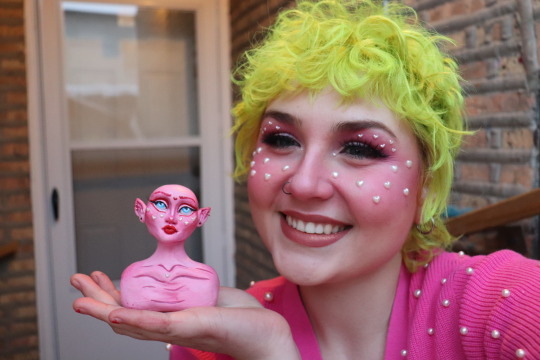
Where are you from? How did you get into creative work and what is your impetus for creating?
So, I was born and grew up on an island in Washington State, then moved to Sakhalin Russia, another island when I was 8. I then moved to Dubai for 2 years when I was 12 and spent my high school years in Aberdeen Scotland which is where I consider home. Complicated? Yes! But I’ve now lived in Chicago for 5 years and hope to maybe move where ever a residency opportunity could bring me.
I’ve always been a creative person, as creativity helps me communicate back to myself, as I have I’ve had a difficult time understanding myself and my own emotions due to … you guessed it, trauma and displacement. But more specifically, I’ve been working with polymer clay since I was a little kid, and would make miniature little towns with my sibling, and the obsession and hyper fixation lasted through middle school. In high school I was into acting and singing where I played the lead in my school plays and even preformed in front of the queen of England! No joke! I then went onto study creative writing with a focus in poetry in college, but that’s where I was able to take classes in metal smithing jewelry as well as stop motion animation.
When I was in art college, I was insecure because I felt like my classmates had always known what they wanted to do since they were kids, but I had just started poetry in college. When I discovered that a career in stop motion was possible, everything fell into place. When I was little and making clay towns, I used to dream of making stop motion movies. I loved Wallace and Grommet and was particularly fond of Coraline. I had a wonderful teacher and mentor named Dino who encouraged me to stick to it. I had gotten back into sculpting and I felt like he really understood and appreciated my work, and I am grateful to him for pushing me towards the live I’m living today.
I now spend every day making earrings as well as sculpting and painting bright colored aliens that are part of a bigger project about aliens coming to Earth, and because they grew up without stigma, they become sex workers. It’s about hyper femininity, queerness and gender roles, and was inspired by my first stop motion film that you can see on my website. I also live and breathe my brand and art shop “GERM” named after my initials G.R.M. where I mostly sell earrings inspired my things like sex positivity and destigmatizing sex work and menstruation. On the side of all that, I teach polymer clay and felting workshops.
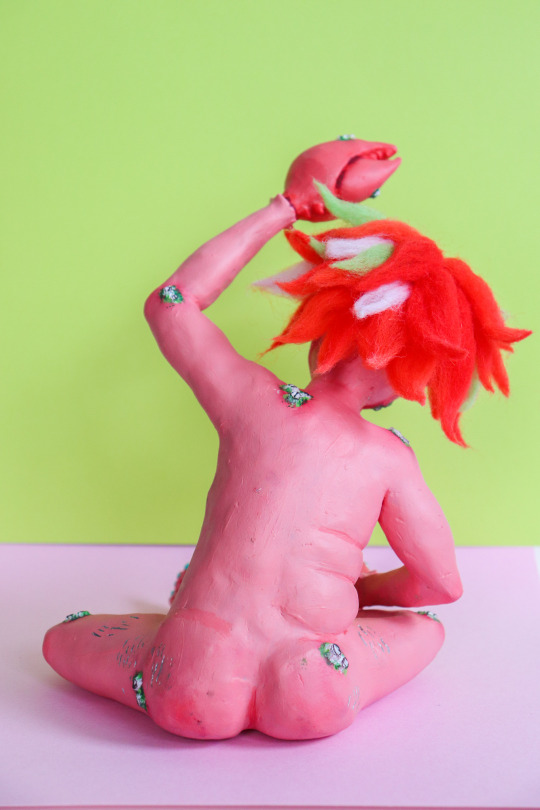
Tell me about your recent exhibit and why it’s important to you. What do you hope people get out of your work?
One of my most recent exhibits of my work was being shown at Women Made Gallery for their Boundaries exhibit. My piece is called “We’re all Cam Girls Now” and is about my life as a sex worker during the Pandemic. I lost all forms of income and was unable to receive unemployment so I became a full-time virtual SW. I had dabbled in SW for years before 2020 as a cam girl, sugar baby, dom etc; it came very naturally to me. I’m a confident person and having a sexual persona online, even in my public accounts was very empowering. People that I’ve never met before would tell me I inspired them to be more confident and I fell in love it my lifestyle. But when it was about survival, everything changed. It was no longer about me, it was about using my body as a product, and as time went by more and more of me slipped away. It wasn’t just a sexual persona, I felt like an object. I felt that I couldn’t say no to things, because I needed to pay rent, I needed to eat, I needed to take care of myself, but I wasn’t. I worked every hour of the day, making content and promoting promoting promoting!!! I didn’t allow myself to take breaks or days off because it felt like the world would collapse around me if I did. Being a part of a show about boundaries, was incredibly important to me. I was able to express the flaws in my work ethic, and dive into what I actually needed to survive. I am so deeply grateful for my loved ones, Mo, Evan and Mercedes for reminding me to slow down, to take days off and actually say no to things. I hope that when people see my work they see past the surface value of sex work and look more into the expression and posture of the sculpture. I want them to see how it feels rather than what it looks like.
Does collaboration play a role in your work—whether with your community, artists or others? How so and how does this impact your work?
I would like it, but I’d be lying if I didn’t tell you that I’m a total hermit. The pandemic took a great toll on the relationships I had with my friends, community and the ability to socialize. Just when march 2020 hit, I was in the middle of working on a stop motion film about Medusa with a team of students from Columbia College Chicago. I have been very solo my whole life and working collaboratively was so exciting to me. Anything that one of us couldn’t do, someone else could, and in such a fresh unique way. It was so inspiring to work with so many talented people that had the same goals as I did. I truly mourned the loss of that project for a long time, so I hope to be a part of an experience like that again soon.
Considering the political climate, how do you think the temperature is for the arts right now, what/how do you hope it may change or make a difference?
In the realm of social justice, the role I’d like to play would be around sex work, sexuality and gender. The earrings I make are primarily sex toys and as of my newest ones, menstrual, and because they’re eye catching both positively and negatively, I want them to open up conversations. I’m trying to be more vocal about the reasoning behind my earrings. Though a great cause to get behind, I don’t make sex toy earrings for sex positivity, I make them in solidarity with sex workers. The dream would be that with every comment someone makes about them, their response would be a statistic or story about someone’s experience. I want conversations to start and grow into change. Same boat with the menstrual cups. Period pride is awesome, but as a non-binary femme, I actually made them to step away from the gendering of menstruation. I wish that periods were not synonymous with women. So many women don’t get them for a plethora of reasons, and vise versa; there are so so so many men and gender non-conforming people that menstruate too. So I hope that maybe some people can talk about that, and spread their views.
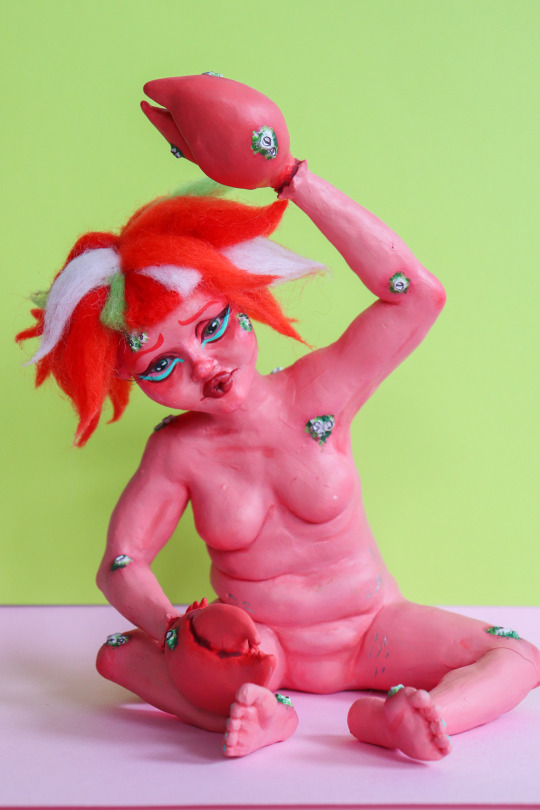
Artist Wanda Ewing, who curated and titled the original LFF exhibit, examined the perspective of femininity and race in her work, and spoke positively of feminism, saying “yes, it is still relevant” to have exhibits and forums for women in art; does feminism play a role in your work?
Yes, but I’ve been struggling with that word. When I was younger, I was all about feminism. From activism to feminist critique; it was a big part of my personality. I now identify as a non binary femme, and it’s been challenging to navigate where I belong in the dialogue of feminism. I am fighting for what feminism is fighting for, and still affected by the same things, but I don’t like how everything focuses so heavily around cis white women. I feel that many people a part of the community are underrepresented or tiptoed around. Though I can’t speak on behalf of POC, as a non binary person, I want to reopen feminism as something that doesn’t focus so heavily around these things. I want nonbinary, POC and trans folx to be a bigger part of the movement as it grows and changes.
Ewing’s advice to aspiring artists was “you’ve got to develop the skill of when to listen and when not to;” and “Leave. Gain perspective.” What is your favorite advice you have received or given?
Abby Jame, one of my favorite artists released a slide show they made about what happens post grad from art school, and one of slides stated “ALL your time goes to your art or you will not be successful.” I think this is definitely a little stress inducing, but it was around the time of finding this quote that I realized I want to be a successful artist. I have a tendency of being a bit of a workaholic but this taught me to create, and when you’re done, create more. I guess I see it as a reminder to work hard for yourself and you will see results, and I have.
-
https://www.gillianmarwood.com/
~
Les Femmes Folles was a volunteer organization founded in 2011 with the mission to support and promote women in all forms, styles and levels of art from around the world. Editor Sally Brown retired from active blogging after 10 years in 2021, but still accepts submissions. [email protected] https://femmesfollesnebraska.tumblr.com/callforart-writing
Check out the 10th anniversary LFF exhibit, Feminist Connect, here:
https://www.les-femmes-folles-feminist-connect.com/
1 note
·
View note
Text
Artist Feature: Kara Dunne
Pleased to present this q-and-a with artist Kara Dunne. All words and images (c) Kara Dunne...

A Trailer is a Castle on Its Side
Where are you from? How did you get into creative work and what is your impetus for creating?
I like to say I’m from Vermont because that’s where I was born and most likely will end up someday. Currently I live in Massachusetts.
My observation skills got me into creative work. I was always good at drawing from observation growing up, and in general observing things that were odd or quirky in the world. Once I tapped into these heightened skills of seeing things in a new way, I think the gift of creativity followed suit. Once you are super-honed into the world around you, you naturally start making unusual connections that you’d like to share (secretly in hopes that you may be the first one to make them of course).
As a practicing artist over the years, my work accumulates around me in boxes and flat file drawers. And since I mostly create multiples of things, sometimes I feel like an unintentional hoarder. But the thing is, unlike a hoarder, I don’t want to hold on to the stuff I make. I have increasingly felt the “what is the point of producing all this stuff?” question that is not unique to the artist’s experience. I can relate to the: “If a tree falls in the forest, and no one is around, then it doesn’t make a sound” concept. If I make work that remains in my flat file, then it too, remains silent. So what is the point? I can only amuse myself for so long by producing for myself. One needs an audience. Coming from a performance background, audience interaction for me was always the most exciting part of the practice. I’ve recently made it my main goal as a printmaker to reach an audience with my work by finding new ways in which I can just give my prints away. I’ve never wanted to sit with my stuff at a table making puppy dog eyes in order for people to stop and buy something from me. No surprise that I was terrible at selling girl scout cookies.
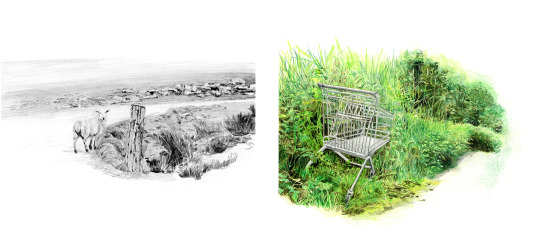
Tell me about your latest project and why its important to you. What do you hope people get out of your work?
Just before the world shut down, which for me was a year before the pandemic because my time was happily consumed as a new mom, I had just finished a long term research project that connected the agrarian and urban versions of what it meant to be a shepherd and gather something. It compared the idea of a shopping cart attendant at the grocery store to that of a traditional shepherd gathering and caring for a flock of sheep. The final result from my years of research into this concept was a limited edition artists’ book, titled, Shopping Cart Shepherds. Printed on a letterpress, it combined drawings, screen-prints and interviews from my conceptual journey that began in 2012 when I spent time in a small town in Ireland (and yes, around sheep and people who raised sheep). I met a local man in his eighties named Tom Tarpey, who had been raising sheep for about thirty years at that point. Strangely enough and quite a rarity in Catholic history, he was the retired priest of the town. He had left the church in order to marry the love of his life. Once a shepherd of the people, he became a shepherd of sheep. What a rare find! I thoroughly enjoy my work when I can interact with the world more directly; when my artistic research connects me to people in places I have never been and with whom I remain in contact with. I have all these great big ideas, and usually I will be hesitant at first (shy?) to make connections with the community in order to see those ideas come into fruition, but ultimately things pan out in one way or another. For example, when I came home from Ireland and was blabbing about sheep, a friend gave me a newspaper article about traditional Basque shepherds still working in this country- in the mountains in Idaho. For a long time, the article was taped to my wall as a reminder to contact some guy I read about named Henry Etcheverry. In 2014 I was awarded a residency at a fabulous spot called Surel’s Place (thank you so much Surel Mitchell), and it gave me the opportunity to the make necessary connections out there for this book. Needless to say, it was an amazing experience and the Etcheverry family embraced me like one of their own; and I learned a lot about sheep. I now consider them my extended west coast family.
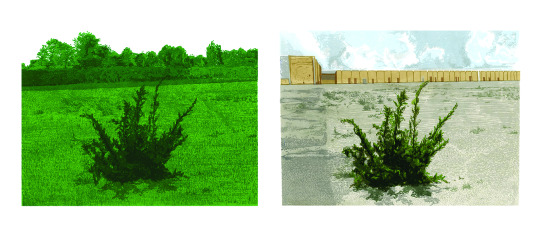
110 copies of the book, Shopping Cart Shepherds, exist (that’s all I could afford to get printed) and inside the back cover it asks the reader to pass the book along to someone else once they finish it. It is my hope that the ideas in this book will travel and reach more than 110 people. (More trees falling in more forests?) I have given away most of the copies at this point, both to people I know and don’t know. The books serve as messages in bottles- it’s honestly difficult to not to have control over where they go, but I guess an artist never really knows where their artwork will end up after it is purchased anyway. Perhaps my books are mostly buried in the sand dunes of someone’s office book pile, or they have actually reached new beaches far far away. I will never know.
Since completing this major work, all of my ideas for making prints have the underlying purpose of getting out into the world and reaching an audience.
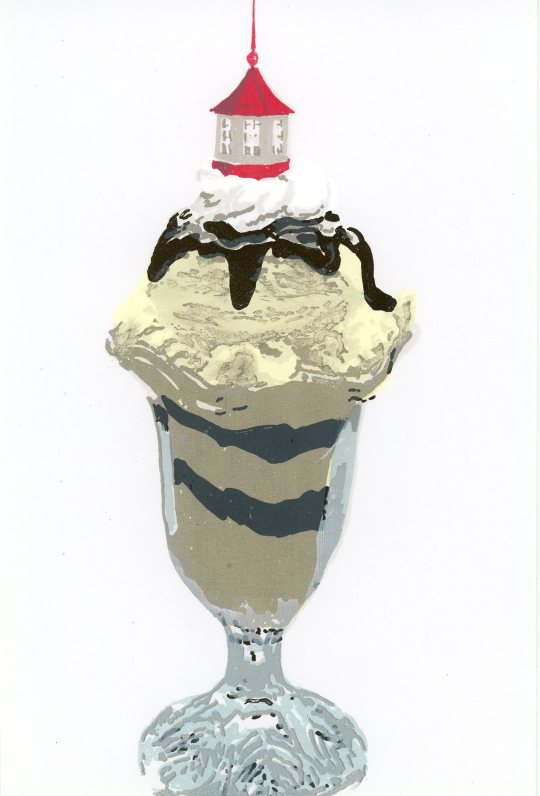
I find certain design elements of architecture to be amusing, and often make work about the structures around us, as they are extensions of our culture and can change with popularity just like anything else. Cupolas, ultimately a very useful and functional architectural ventilation add-on to barns and other large buildings, have been on the rise where I live. Decorative cupolas mainly, seem to show up on top of garages overnight, like cherries atop sundaes. (Makes the sundae and the house look better). I made an edition of screen-prints based on this idea- a vanilla sundae with chocolate sauce and sprinkles in a fancy glass serving dish…with a cupola on top. To get them out to cupola-adorning people, I made up a survey of questions about cupolas. I printed the survey onto paper door hangers and distributed them. The survey could be cut out from the door hanger as a postcard and mailed to my special P.O. box in town. If the survey was sent back, that household would receive an original artist print. I had the post box and distributed the door hangers for a few months before I had to stop the project because of the emergence of covid. I had received at least a dozen responses at that point, and mailed out a portion of the edition. I’d like to start it up again at some point.
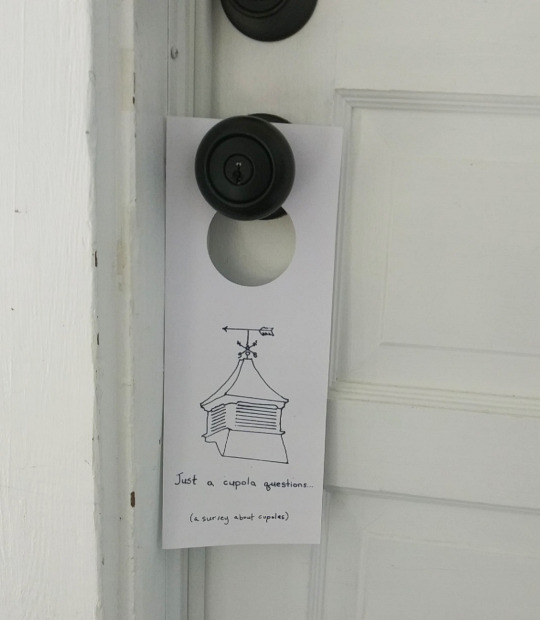
My next print- based community outreach project idea is in process now and will involve restaurant placemats. I just need to make some local restaurant connections. (Another pre-pandemic idea forced to simmer on the back burner). Here’s the basic idea. A table at a restaurant is the perfect gallery space. It is especially ideal because it is the location where a group of people will sit and wait for a long period of time together with nothing else to do but sit and chit-chat in one place. Not even in a gallery do you have the same group of people staying near each other and talking for longer than fifteen minutes in front of a single artwork.
A paper placemat at a restaurant is viewed for a longer period of time than a work of art on a gallery wall. It is hard not to look at a placemat- it is one of the few places to look while waiting for food. I will use the format of the dining placemat as a way to bring fine art into the everyday world. I believe an etching is the perfect kind of print for this project. An etching is considered the finest of fine art printmaking, mainly because the process of making an etching plate is just as time consuming as printing the edition itself. Also, it would be perfectly ironic if a plate made a placemat. And the thought of such a sacred piece of paper so carefully processed as an art work that should end up underneath someone’s sweaty beer glass and dinner plate is simply…exciting to me. Equally, the thought that a restaurant guest may decide to not get it messy because they want to take it home is the kind of leave-it-to-chance scenario that I gravitate to as an artist; it forces me to relinquish my control and challenges the idea of art as an artifact. For the viewer, the idea plays with the preciousness of “art” and the context in which we view a work of art (in a gallery vs. the real world). For the restaurant owner, it may also bring more business and create a new kind of hype attracting more customers. Let’s say I print a series of five placemats, and if people collect all five placemats they get a free limited edition non-placemat print worth X amount of dollars. Or maybe they collect all five and get ten dollars off their next meal. Something like that.
This project connects directly with the public and gets the fine art print into the hands of the everyday person. The imagery within the frame of the placemat will vary- from beautiful local scenery and landmarks (as everyone enjoys a pretty picture), to several different designs that will engage the table with non-phone related activities- like a dining room scavenger hunt or a list of dinner conversation starters, as well as other designs that are more cerebral and open to interpretation, serving as conversation starters themselves (with digestion friendly, witty imagery). It is also my intention to make one of the placemats at each table have a QR code with a link to a video of how the placemat was produced, essentially educating the public about what an etching is, and moreover- what printmaking is.
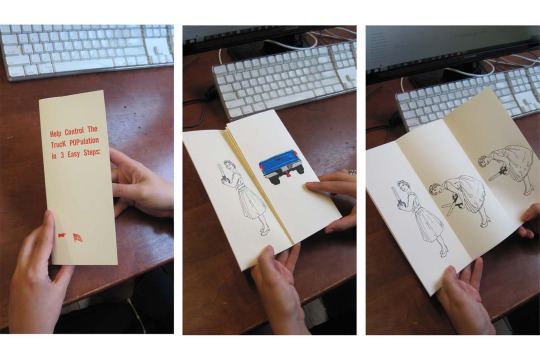
Considering the political climate, how do you think the temperature is for the arts right now, what/how do you hope it may change or make a difference?
The climate is quite volatile right now, to say the least, and I think artists have a responsibility now more than ever to connect people from both sides of a political issue in order to start a meaningful conversation. I think the temperature for artists right now is great- get in the pool! Art always impacts at least one person looking at it, so that’s something. Art is mainly a non-confrontational way to interpret something about the world that needs to change for others who may not understand why change needs to happen. The best example I can think of within the visual arts is installation and involves statistic- based information. For example, a person may come across a beautiful sculpture of a sea monster made from plastic cups. Then they read about the work and how two million cups were used to make the work and that two million cups end up in the ocean every day; that person now has the physical representation in front of them of what two million actually means and it is forever burned into their mind. That person can stand next to the giant sculpture of cups and can better understand what the number means in relation to how it impacts the environment. A real life artwork that is forever burned in my mind like this is a video piece by the ceramic artist Ehren Tool called the ‘1.5 Second War Memorial’. In it, every 1.5 seconds a cup is shot and breaks. Each cup represents a human life. You would have to watch the video for eight minutes to get to the number of people who died in the Gulf War (Tool is a veteran of that war) and watch the video for two years to get to the number of total casualties in WWII.
Artist Wanda Ewing, who curated and titled the original LFF exhibit, examined the perspective of femininity and race in her work, and spoke positively of feminism, saying “yes, it is still relevant” to have exhibits and forums for women in art; does feminism play a role in your work?
More often than not, feminism lies under the surface of my work. How can it not, as I am living as a woman in this world? Feminism is always going to be relevant. It does not end, it is forever in existence; Feminism should not be considered as waves of the past, but as the water itself. I hate that ‘feminism’ is still considered a ‘dirty’ word. Mostly I experience this as a high school teacher, when every so often I will have a male student who expresses their thoughts about what they think feminism is and after I cringe, mostly internally and sometimes externally, I sadly realize that this wrongly informed opinion comes from the belief system of the parents. I try my best to inform them of what is true and false without becoming pushy; it is my hope that these particular students gain more perspective in the world through life experiences once their bubble becomes bigger- and of course once their bubble of close-mindedness has popped.
Ewing’s advice to aspiring artists was “you’ve got to develop the skill of when to listen and when not to;” and “Leave. Gain perspective.” What is your favorite advice you have received or given?
One of my first professors, Nick Tobier, had a five line mantra of sorts that he told us to write down during his first lecture.
“Public space is yours to take.
Reveal the things that are hidden.
What you see has been filtered for you.
Let private notions become public.
You can make icons”
-
https://www.karadunne.com/
~
Les Femmes Folles was a volunteer organization founded in 2011 with the mission to support and promote women in all forms, styles and levels of art from around the world. Editor Sally Brown retired from active blogging after 10 years in 2021, but still accepts submissions. [email protected] https://femmesfollesnebraska.tumblr.com/callforart-writing
Check out the 10th anniversary LFF exhibit, Feminist Connect, here:
https://www.les-femmes-folles-feminist-connect.com/
1 note
·
View note
Text
Artist feature: Christine Holtz
Thrilled to present this q-and-a with artist Christine Holtz! All images and text (c) Christine Holtz.
...
Where are you from?
I currently reside in St. Louis, Missouri with my husband and two daughters.
How did you get into creative work and what is your impetus for creating?
I have been creating for as long as I can remember, but my conceptual work really started when I was in undergraduate school. My impetus for creating is to visually embody the absurdities of my daily experience. It’s how I make sense of the world.
Tell me about your current work and why it’s important to you. What do you hope people get out of your work?
Repetition becomes routine.
Routine creates habits.
Habits generate absurdity.
Absurdities infiltrate identity.
Identity gets lost in repetition.
Repetition becomes routine.
How we understand things depends so much on habit, yet repetition and familiarity often get in the way of ever really understanding anything. I constantly try to make sense of the nonsensical through installations, sculptures, and performances. My ongoing body of artwork is a visual diary about my obsessive thoughts and humorous take on habit, identity, and time. I realize my experiences are not unique, and I hope to connect with others through commonality. For example, my ongoing fascination with identity shows through in my self-portrait work. In #therealme series I embroidered over-filtered self-deprecating self-portraits to embody distorted identity posted through social media. The slow repetitive process of embroidery contradicts the immediacy of an Instagram selfie and forces me to thoroughly engage the imagery thread by thread.

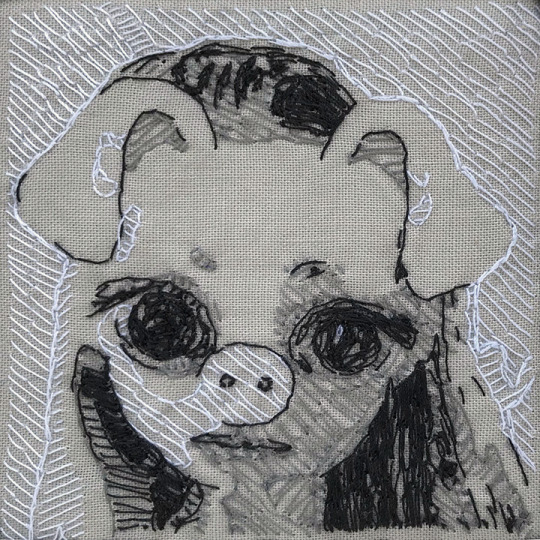

Additionally, every three years since 2005, my Spare a Square for Unibrow Care project requires me to collect my plucked eyebrow hairs and "draw" a new self-portrait on a square of toilet paper by dipping each hair in glue and applying it with tweezers. The excessive repetition and extreme dedication taken to complete my visually overwhelming compilations tests the limitations of both my mind and body. Each of these projects is an attempt to gain an understanding and control over the habits of my life as they are unfolding before me. I meticulously craft ridiculous objects and performances to visually embody my daily experiences that I find absurd.
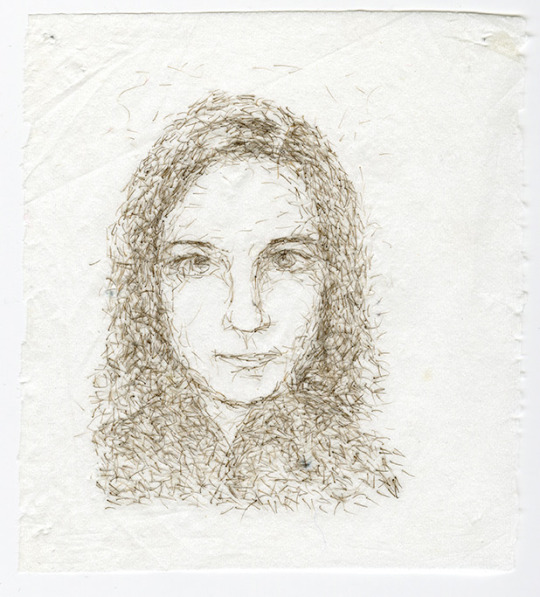


Some of my works over the past ten years are specifically about motherhood. At the start of the pandemic, I felt the need to create a uniform as a mother, college instructor, artist, and all of a sudden also a homeschooler. Covid-19 Work Blazer is my humorous attempt to maintain a sense of professionalism during these unprecedented times. The blazer has the extra arms needed to keep my family from losing balance in our “new normal.” The sewn gesture drawings paired with repetitive hand embroidery are both an illustration and metaphor for parenting. Hand embroidery requires a lot of control and repetition−very much like raising children. Likewise, in freehand machine embroidery, the machine wants to move in one direction while I encourage it to sew in a more desirable path. The processes are both a struggle and cathartic−just like parenthood.

Process plays a huge role in my art practice. Sometimes the performance is the repetitive process of making or collecting materials. Other times I make a sculpture to be used for a performance. Oftentimes it is both. I see methods of making as representation for repetitious actions. For example, Mumbleweed is composed of strips of hand-cut paper covered in hundreds of phrases I found myself saying over and over as a parent. Repeatedly saying the phrases on a daily basis wasn’t absurd enough, so I forced myself to sit and write them again and again as a performance in creating this piece. The sculpture is meant to quietly drift into the corner and go unnoticed just like the countless hours of my parenting words lost to the wind.
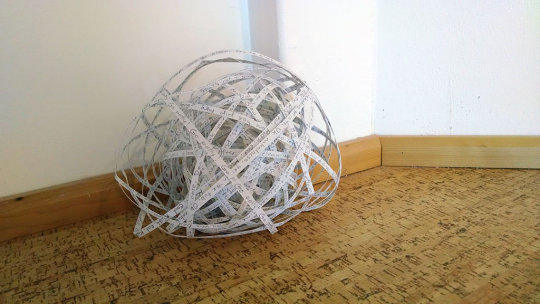
Does collaboration play a role in your work—whether with your community, artists or others? How so and how does this impact your work? In past works, I involved the community in the process more. Some of my past performances were large public displays. For example, my group performance piece as a mascot of myself in the University of Missouri homecoming parade was to commercially promote my exhibition on campus. In the field of art, we have to be our own mascots. My mascot persona hasn’t made an appearance since becoming a mother. I am not sure why exactly, but it will eventually be used as an ageless version of myself. For now, I have been collaborating with my husband (who is a photographer) and daughters for some more recent works. My visual diary is constantly evolving.
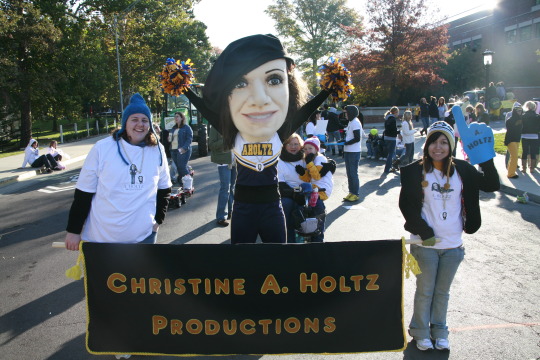
Considering the political climate, how do you think the temperature is for the arts right now, what/how do you hope it may change or make a difference?
Throughout all of history, art has served as a reflection of the time. Now is a time to fight for equity. I realize that I not moving mountains with my work, but I feel the need to make this work about my shared experiences. I hope to make a difference by providing a strong and accepting example to my daughters just like my own mother has shown me. Mother, the fate of the free world rests in me! exemplifies this feeling. One night before bed, I crocheted a doily and the next morning I found Wonder Woman tangled in the string and slowly unraveling the work that I had done the night before. As a feminist, I want to create confidence and equal opportunities for my daughters’ futures. This sculpture is about embracing the random happenings of raising two daughters while guiding them to find their own strengths and identities without the constraint of social constructs.
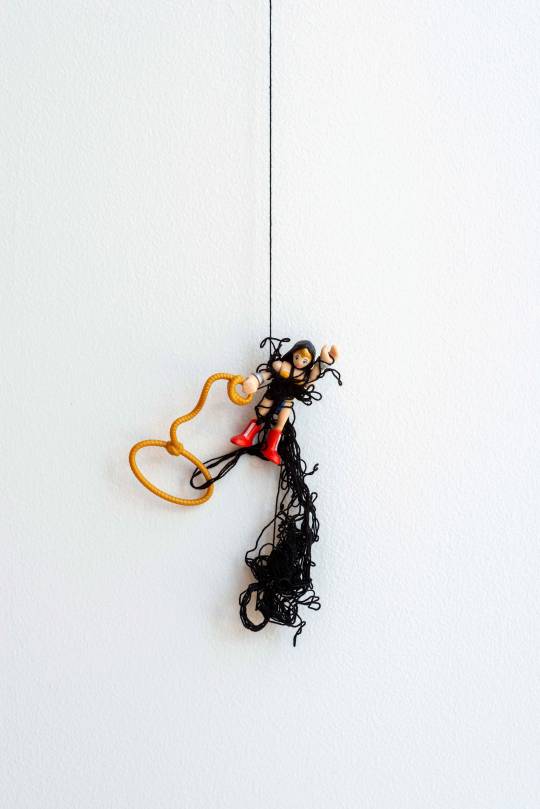
If you would like to check out more of my works, please visit my website christineAholtz.com
I have considered making a separate Instagram page just for my art, but that wouldn’t make sense with my concept. My life goes hand in hand with my art making. You can follow me @holtzchristine
~
Les Femmes Folles was a volunteer organization founded in 2011 with the mission to support and promote women in all forms, styles and levels of art from around the world. Editor Sally Brown retired from active blogging after 10 years in 2021, but still accepts submissions. [email protected] https://femmesfollesnebraska.tumblr.com/callforart-writing
Check out the 10th anniversary LFF exhibit, Feminist Connect, here:
https://www.les-femmes-folles-feminist-connect.com/
0 notes
Text
Poetry feature by Monica Viera
The Taste of Rape
Most people can relate,
To the feeling of having the taste of something in
Their mouth
That they NEED to get rid of.
Maybe it’s bad milk, a strange vegetable, whatever.
But did you know the same sensation is true of your vagina?
If you’ve ever been molested or raped,
You may have this impulse,
To clean yourself out,
And get the closest and most convenient thing around you-
Often in the form of a flesh tampon
-A dick-
And stick it in you,
In an urgency
To take the taste of rape
Out of your hole.
For you have these set of lips
That have been beaten and silenced
With the taste of someone unfamiliar hitting them
Begging to be washed out
With a taste is so dominating,
That if you let it ravish you,
Can become your death.
-
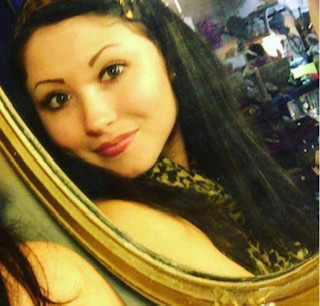
Monica Viera is a Hispanic published poet from East LA who writes about mental health and feminism. Her Instagram is miss.noirotic.
~
Les Femmes Folles was a volunteer organization founded in 2011 with the mission to support and promote women in all forms, styles and levels of art from around the world. Editor Sally Brown retired from active blogging after 10 years in 2021, but still accepts submissions. [email protected] https://femmesfollesnebraska.tumblr.com/callforart-writing
Check out the 10th anniversary LFF exhibit, Feminist Connect, here:
https://www.les-femmes-folles-feminist-connect.com/
0 notes
Text
LFF Semi-retiring after 10 years, New Website BDAY GIVEAWAY
Giveaway info below....
I started LFF in 2011...I wrote a little bit about “why” on my About page, and a little more on my posts about Wanda Ewing. I was writing a local art column, getting back into the art scene after babies, and found a lack of coverage/exhibitions of women artists. But really, I think, I was looking to justify my want to create my own work as a mom--as mom’s often this can feel selfish, carving out our own identity--and too, as a semi-provocative artist, I sought to find my voice, and camaraderie. Interviewing women, curating exhibitions and events, producing art books and anthologies dedicated to women-identifying and mother artists, helped me feel confident to express myself, a process that continues.
In these ten years I’ve interviewed over 1,000 women (broadly defined), published several books (anthologies and illustrated books), hosted several exhibitions and events, and posted many reviews and blog posts around women artists/exhibitions/creatives. It’s undoubtedly impacted my own work and perspective and I’m stoked to have this documented online. More documentation is still needed for women (especially women of color) artists, as change is slow. I’ll continue my writing, interviewing and curating, and leave LFF up for any interest in the future, but I won’t be pursuing actively anymore--instead spending more time dedicated to my own work (which of course is inspired by other artists and I acknowledge that!).
I have JUST LAUNCHED my new fabulous beautiful website dedicated to my art, writing and curating at http://sallyjanebrown.com/!!
In celebration of this, the 10 years of LFF, my BDAY this week and a solo show next month at Rhoneymeade Botanical Center in Pennsylvania...I’m doing an Instagram give away of some of my prints and art!!
Five winners will receive this 11x17″ color print of a pastel drawing I did in college:
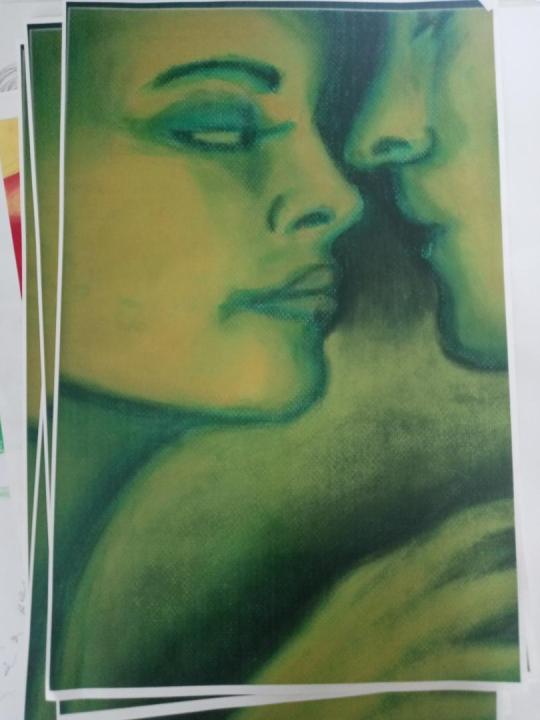
One person will win a body print of their choice!:
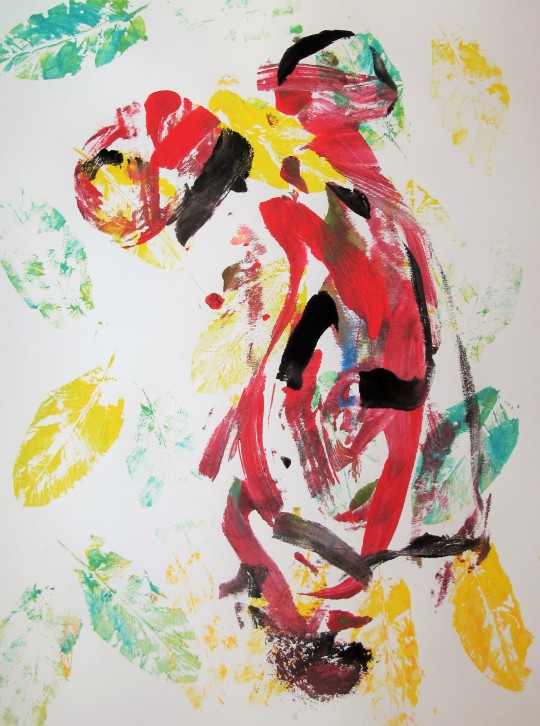
Tribute to Adrian Piper
One person will win a Feminist Tribute drawing of choice:
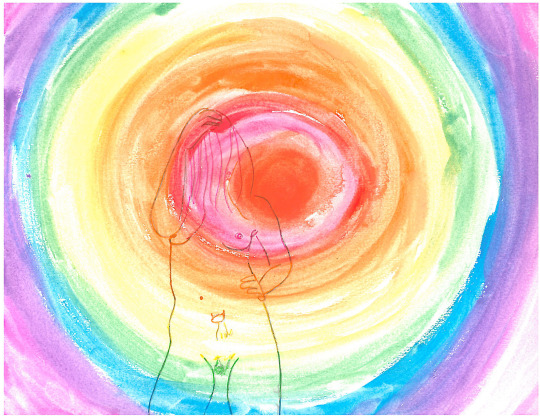
Tribute to Alma Thomas
All you have to do by Friday, August 13 at midnight ET!:
1. Follow me on IG: @sallery_art
2. Like my post about this giveaway
3. Repost or share and tag me so I know and post a friend who might also enjoy it!
Winners announced by Sunday August 15!
Let’s do this!! <3
1 note
·
View note
Text
Artist Feature: Eva Montealegre
Artist Eva Montealegre shares with LFF about her work in the show, ANOTHER YEAR IN LA, collaborating with other artists and musicians, the importance of feminism in her work and more...All images and text (c) Eva Montealegre.
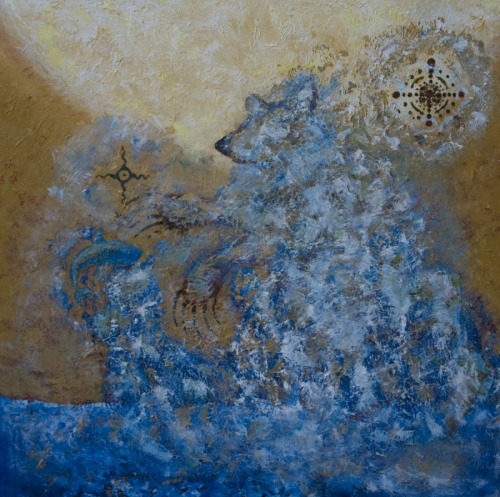
Bear Spirit
Where are you from?
I was born in St. Louis, Missouri. Down by the Mississippi. Grew up on the showboat, The River Queen docked on the river in downtown St. Louis.
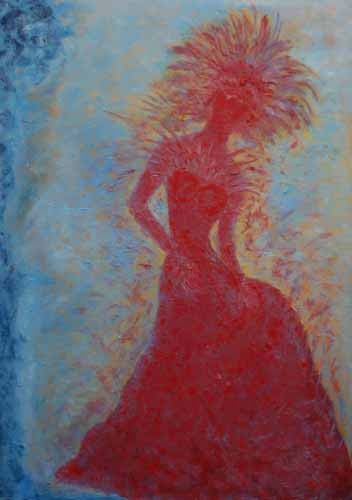
Party Queen
How did you get into creative work and what is your impetus for creating?
My mother was a writer and my father a sculptor. It's in my blood, my family culture, and my emotional vocabulary. It is the heartbeat of my life.
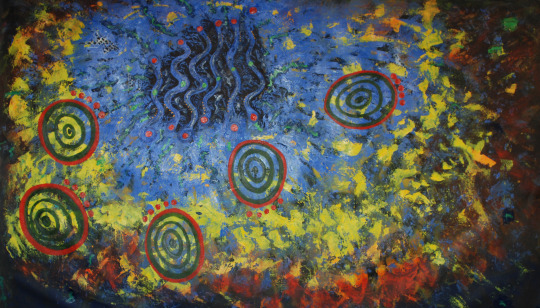
Birth of a Universe
Tell me about your current exhibit and why it’s important to you.
I'm in an online show, ANOTHER YEAR IN LA. It features a classic nude in a twist on the Maha style of the masters, sort of like Modigliani on mushrooms.

Deep Vein 3
What do you hope people get out of your work?
I'd like for people to experience joy, to drop a tear or smile when they see my work.

Deep One
Does collaboration play a role in your work—whether with your community, artists or others? How so and how does this impact your work?
I have collaborated with Beatriz Vaquez and underground classical musicians. Together we did a performance for scientists, professors, students, and the community at the Gallery of Genetic Arts on the USC medical campus. We danced the story of the birth of the universe using my painting depicting the theory of Nobel recipient Peter Higgs as a set backdrop. It was so joyful and we made a point of including the audience in the experience. The young dancers created their own headpieces of their costumes. Each chose a comet or an asteroid or a nebula and so they knew their role in the universe. I did a similar thing at Pierce College with students. Collaboration equals exponential joy in my world.
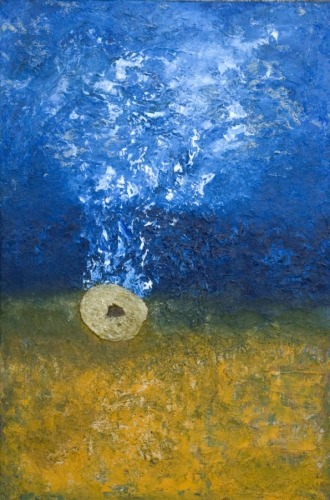
Ancient Habitat
Considering the political climate, how do you think the temperature is for the arts right now, what/how do you hope it may change or make a difference?
I expect only good things for the arts in LA.

Rosie
Artist Wanda Ewing, who curated and titled the original LFF exhibit, examined the perspective of femininity and race in her work, and spoke positively of feminism, saying “yes, it is still relevant” to have exhibits and forums for women in art; does feminism play a role in your work?
Feminism is everything to me. It is the true pulse of humanity. All people, absolutely everyone benefits when women thrive. It's all connected, woman is not separate.
Ewing’s advice to aspiring artists was “you’ve got to develop the skill of when to listen and when not to;” and “Leave. Gain perspective.” What is your favorite advice you have received or given?
The best advice I ever got was "Do what you want."
-
www.evamontealegre.com
~
Les Femmes Folles is a volunteer organization founded in 2011 with the mission to support and promote women in all forms, styles and levels of art from around the world.
Submissions always open: https://femmesfollesnebraska.tumblr.com/callforart-writing
Check out the 10th anniversary LFF exhibit, Feminist Connect, here:
https://www.les-femmes-folles-feminist-connect.com/
2 notes
·
View notes
Text
Artist feature: Silky Shoemaker
Artist Silky Shoemaker currently has work included in Womanmade Gallery’s Water Becomes Blood exhibition. She shares with LFF about her impetus for creating, making work around queer history and icons, the climate for artists right now and much more... All images and text (c) Silky Shoemaker
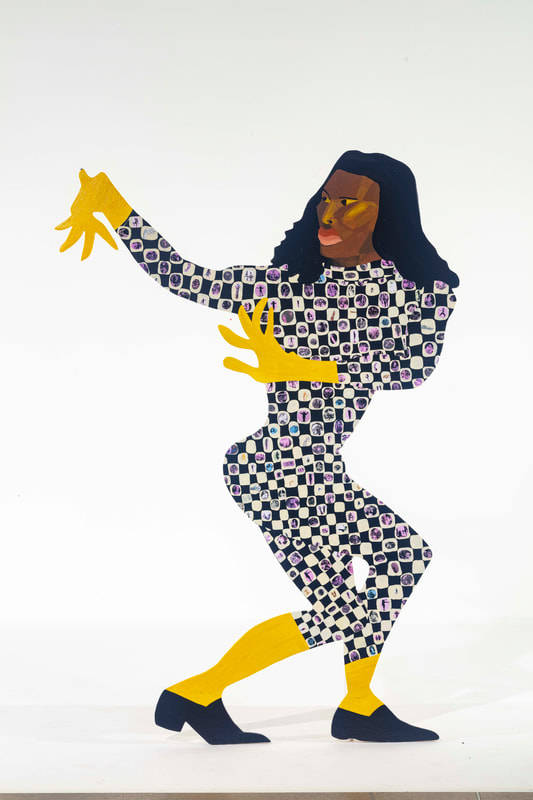
Willi Ninja, 75" tall, house paint and collage on plywood from "Queer Icons" series
Where are you from? How did you get into creative work and what is your impetus for creating?
Im from rural Pennsylvania, a small town right in the middle of the state but for most of my adult life ive lived in austin, and the bay area more recently. i grew up with creative parents-- my dad is a painter and my mom designed costumes for local theater. i was very into theater as a kid and i think that was my first inspiration-- the ability to create elaborate worlds and adorn them according to my weird little notions. i would write plays for the neighborhood kids and we would perform them at birthday parties and nursing homes, or i would make a fake museum in the basement and charge people a quarter to come look at it. i love the meeting point of history and fantasy and that is still an impetus for my work-- especially considering queer history as a malleable and impressionable source.
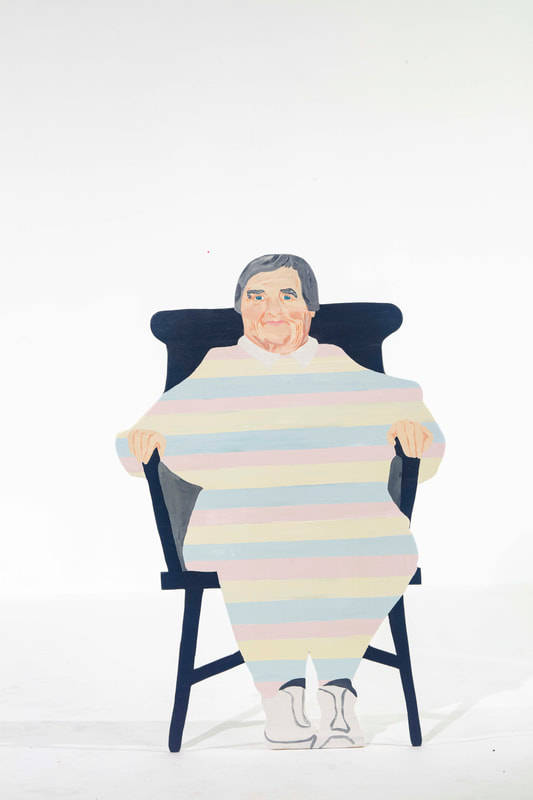
Agnes Martin, 48", housepaint on plywood, from "Queer Icons" series
Tell me about your current project and why it’s important to you. What do you hope people get out of your work?
for the past two years i have been making life size wooden cut-outs of icons from queer history for a gallery in new jersey. over the next year i want to make 49 more--69 total-- and fill up a big art space somewhere with lots of amazing underacknowledged characters from our lineage. i want to celebrate queer ancestors and hopefully share their story to new audiences.
queer community is the driving force behind my art. while i generally paint solo, and actually hermetically like a little troll in a cave a lot of the time, what supports and inspires me is queer community (both historical and present) and the desire to contribute to it. i do performance work, most often in an absurd three person anarcho vaudeville troop called Shaboom!, and that is a deeply totally collaborative project. that work is very improvisational and unfiltered, and it indirectly but profoundly feeds my visual art practice-- it reminds me to step out of my brain, be open to change and flow, and to have fun--- to trust the impulses of inspiration and take risks.
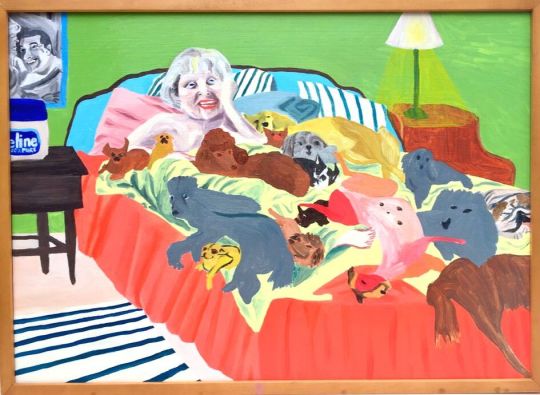
Doris Day Nude in Bed Covered in Vaseline with 16 Rescue Dogs from “Diva” series
Considering the political climate, how do you think the temperature is for the arts right now, what/how do you hope it may change or make a difference?
i think political depression is a real thing and it can be really hard to create art in a hostile political climate and with an administration that actively withdraws support from artists and attacks marginalized communities. and in a purely material way, its hard to make art when you cant afford supplies or are busy fighting for your basic rights. for me though, ive felt pretty motivated by the hell of the trump era and its lit a fire under my ass to make some art i was surprised to find myself making. specifically, my brother and i made a series of anti-trump billboards that were installed around rural PA in the lead up to the 2020 election. that lead to a large scale sculptural installation this spring inspired by the capitol riots. i think art can move minds in a way that less abstract modes sometimes cant, so i hope these projects hit those marks and made some neurons light up and connect in some new pathways for people and with the billboards especially i hope they made centrist voters in this area consider never ever voting for that asshole again.
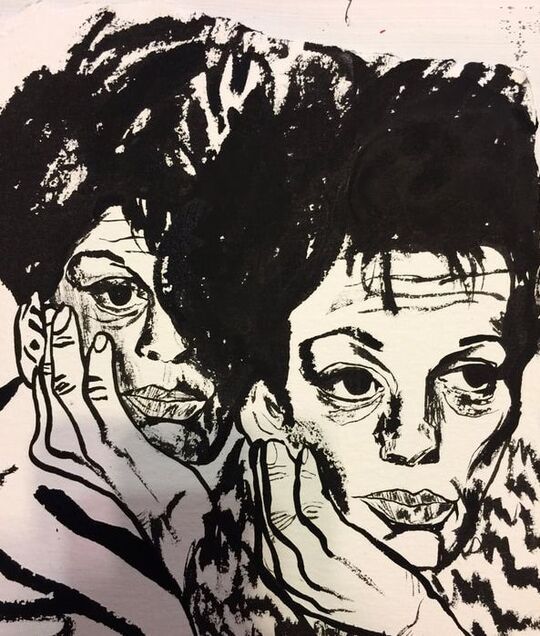
Judy, ink drawing, from "Tears and Laughter They Know About" series
Artist Wanda Ewing, who curated and titled the original LFF exhibit, examined the perspective of femininity and race in her work, and spoke positively of feminism, saying “yes, it is still relevant” to have exhibits and forums for women in art; does feminism play a role in your work?
feminism is like the lense through which all my thought is filtered. my queer identity is completely intertwined with feminist ideology and i could never identify how i do or create the work i make without it.
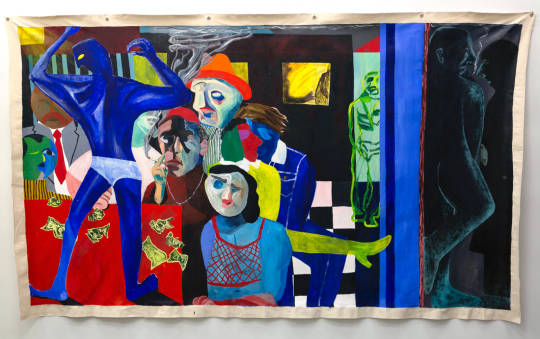
Go-go dancer, from “Thee Glorious Hole” series
Ewing’s advice to aspiring artists was “you’ve got to develop the skill of when to listen and when not to;” and “Leave. Gain perspective.” What is your favorite advice you have received or given?
recently someone told me not to apologize for myself. that really struck a cord. i find it hard to claim the title of artist, sometimes, i still have imposter syndrome, feel like im not good enough to be part of the conversation. but remembering that we all have the right (and responsibility!) to show up and contribute and to stand in that knowledge is really empowering to me. let that light shine.
https://www.silkyshoemaker.com/
~
Les Femmes Folles is a volunteer organization founded in 2011 with the mission to support and promote women in all forms, styles and levels of art from around the world.
Submissions always open: https://femmesfollesnebraska.tumblr.com/callforart-writing
Check out the 10th anniversary LFF exhibit, Feminist Connect, here:
https://www.les-femmes-folles-feminist-connect.com/
0 notes
Text
Artist feature: Corinne Lightweaver
Artist Corinne Lightweaver recently published her second book, THE PSYCHE’S GIFTS: Art, Art Making, and the Journey from Mental Illness to Mental Wellness, featuring a series of artworks that reflect her personal experience while living with mental illness. She shares with LFF about how she came to discover assemblage, the significance of her new book, some of her work and narrative behind it, making work as a feminist and more...All images and text (c) Corinne Lightweaver.
Where are you from?
I have lived in many places, but I’ve spent most of my life in Los Angeles. I’m now living on Vashon Island, WA, which has a thriving arts community. I live on a forested property and take inspiration from drives through the woods, among rolling pastures, and along the rocky beaches of Puget Sound.

Conspicuous Lack, c. 2010, collage in collage journal, 9.75 x 15 inches.
This well-turned out couple is likely dressed in their best clothes for an airplane flight, as used to be the custom. They may pass as heterosexual “pals,” but not to “people in the know.” The written text reads, “In the absence of models, there were worlds I couldn’t imagine. I only felt a conspicuous lack.” When I came out in 1982, I knew and saw few people who were LGBT. It felt true to me, but I also lived in an “in-between” space because my identity was not validated.
How did you get into creative work and what is your impetus for creating?
I hope that my work invites people to think differently about the subject matter I portray. I signed up for a drawing class 27 years ago on a whim when the computer class I wanted was closed. A few classes later I was hooked. From pencil drawing I moved into colored pencils and then acrylic and oil painting. My favorite subject was wildlife, particularly Indian rhinos, chimpanzees, and rhesus monkeys that I learned about through working with a zookeeper as a volunteer at the Los Angeles Zoo during high school. I wanted people to see the humanity in them for lack of a better word.
In 2007, I was diagnosed with breast cancer. I joined an art therapy group and my art took a different direction. I found that cutting, piecing, and pasting was an excellent way to access my unconscious fears and put my life back together again. I also discovered assemblage during this time and loved it for similar reasons. In 2010, I published a book about this body of work, entitled In the Breast of Health: Healing from Cancer through Art.
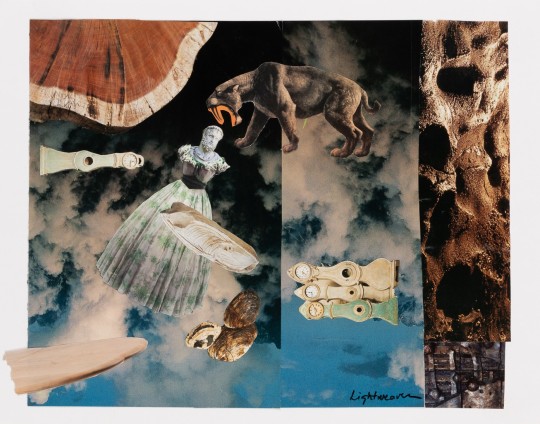
Devoured, 2016, collage on paper, 14 x 17 inches.“Devoured” illustrates my despair and fear about my adolescent daughter’s extreme behaviors. It stands in stark contrast to traditional portrayals of motherhood. I was being devoured by her and all her needs. Represented by the saber toothed tiger, she is a menace and a threat. I am the statue, frozen in fear for her safety and mine. I am armless, indicating the lack of power I felt. Organic textures, clocks, shells, and classical statues are part of my personal lexicon and are seen often in my work.
Tell me about your current/upcoming book and why it’s important to you.
My new art book, The Psyche’s Gifts: Art, Art Making, and the Journey from Mental Illness to Mental Wellness, documents my experience with mental illness. I started creating this work in a collage journal that I never expected to share with anyone. As it grew into a body of work, I revisited the collages and saw that they form a memoir of sorts about my struggles with the obsessive compulsive order and depression that hijacked my brain in adolescence. Reviewing the arc of my story helped me, and I hope many others, to understand the interior experience of mental illness and the possibility to heal, even if there is no cure.
What do you hope people get out of your work?
The theme of the “crazy” and mentally ill artist captures the public’s imagination. Certainly there are those of us whose mental suffering happens publicly and may be displayed in extreme forms. And at the same time, there are many of us artists who are able to hide our symptoms and pass as “normal.” As we artists often serve as the “canary in the coal mine,” I believe our willingness to give visibility to these topics lives in the arena of social justice.
My hope in sharing my own work about mental illness is to spark personal and public conversations, reduce stigma, and encourage those who suffer to seek help.

The Whispering Women We Were Whispering About, 2020, collage on paper, 14 x 11 inches.
So much of lesbian history has been buried as many female “friendships” passed under the radar of persecution and because of the prevalent viewpoint that female sexuality exists only in juxtaposition to a penis. The women’s love is honored with a halo. They are present both in the domestic sphere, represented by the stove, and the greater society, represented by the rotunda. The gentle scene contrasts with the lava above and the 1906 San Francisco fire below. Amelia Earhart bears witness to their love.
Does feminism play a role in your work?
I always create from the viewpoint of a feminist and as someone who lives her life openly as a lesbian. My work may not always reveal that vision, but being a cisgender lesbian female who is comfortable in her own skin defines who I am. Living as a woman who proudly loves women is still a revolutionary and feminist act.
https://www.corinnelightweaverstudio.com/
~
Les Femmes Folles is a volunteer organization founded in 2011 with the mission to support and promote women in all forms, styles and levels of art from around the world.
Submissions always open: https://femmesfollesnebraska.tumblr.com/callforart-writing
Check out the 10th anniversary LFF exhibit, Feminist Connect, here:
https://www.les-femmes-folles-feminist-connect.com/
1 note
·
View note
Text
Artist Feature: Jody Zellen
Artist Jody Zellen shares with LFF about the variety of media and evolution of her work, her current net art project, making conceptual and political, visual pleasing work and more...All art and text (c) Jody Zellen.
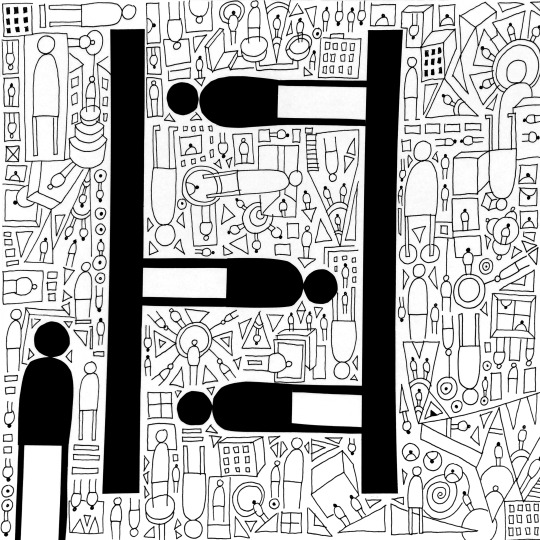
Drawn Collage
Where are you from?
I grew up outside Boston, MA and came to Los Angeles for grad school in 1986. I have lived in Los Angeles for so long now, I consider it my home.

Ghost City - Avenue S
How did you get into creative work and what is your impetus for creating?
I have always "made art." At first I was a photographer who went everywhere with a camera and framed aspects of the world around me transforming "reality" into black and white abstractions. I later created cut and paste collages. After I got a computer and learned Photoshop, I began to make digital works. I have recently returned to drawing and painting, in addition to continuing to make digital works and animations.
My impetus for creating is to share how I see and interpret what surrounds me. To that end I have created public art, net art artist books and interactive iOS apps that are available for free to anyone with an iPhone. (http://www.jodyzellen.com/apps)
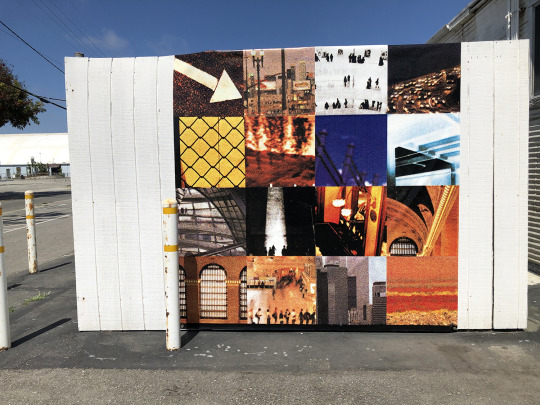
Grid City
Tell me about your current project and why it’s important to you.
Since the beginning of the pandemic I have returned to making net art — interactive webpages. The project I am currently engaged with is called Avenue S and can be accessed from a net art site I first began in 1998 called "Ghost City" (http://www.ghostcity.com/avenue-s). "Avenue S" can be seen as a pandemic journal, a meditation on the last year — reflecting on isolation, riots, nature, etc. It now has close to 300 unique web pages.
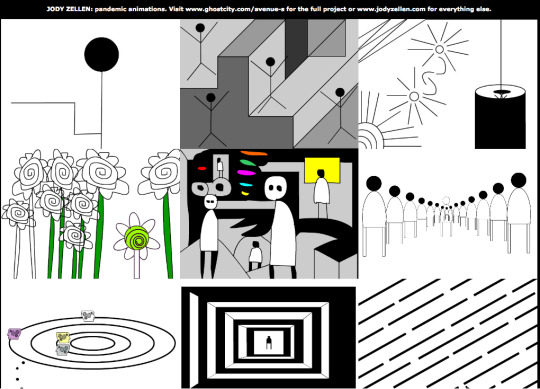
Pandemic Animations
What do you hope people get out of your work?
While my work engages with conceptual and political concerns, I also want to make work that is visually pleasing and stimulating. I want my works to be accessible and available to wide audiences— that is why I first created net art, then free iOS apps and public art. I aim to inspire people to think about the relationship between what is seen and what is imagined.
-
http://www.jodyzellen.com
http://www.ghostcity.com/avenue-s
~
Les Femmes Folles is a volunteer organization founded in 2011 with the mission to support and promote women in all forms, styles and levels of art from around the world.
Submissions always open: https://femmesfollesnebraska.tumblr.com/callforart-writing
Check out the 10th anniversary LFF exhibit, Feminist Connect, here:
https://www.les-femmes-folles-feminist-connect.com/
0 notes
Text
Artist feature: Jennifer Mannebach
Artist Jennifer Mannebach shares with LFF about the impact of her religious childhood in her artmaking, her work currently included in the Boundaries at Woman Made Gallery in Chicago, creating art during this political climate, the complexities of defining “feminist art” and more...

Where are you from? How did you get into creative work and what is your impetus for creating?
I grew up in the Midwest in a large Catholic family that was touched by mental illness. There was a great deal of denial, subterfuge and taking refuge in religion. This influenced the way I began to think about belief systems, boundaries and things that fall away. What is visible and what is not? It’s confusing for a child to witness denial of things that are clearly there, while at the same time swear allegiance and faith to things that are invisible and unproven. As an adult, I’ve had to overcome fear and negotiate the desire to compartmentalize. I make things in order to understand my own thoughts and questions. Some explorations can develop through conversation or writing, but the catalysts for my visual art are often questions I can’t even articulate. The material studies in the studio are my way of accessing my smarter self.
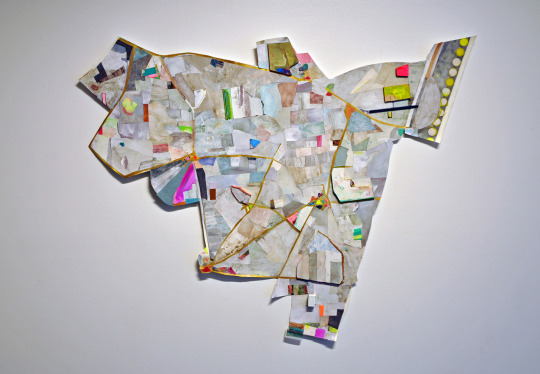
Jennifer Mannebach: NO PLACE (2020), paper, paint, wood, mylar, leather, silk, acrylic, 42 x 45 in.
Tell me about your current exhibition and why it’s important to you. What do you hope people get out of your work?
I currently have a piece in the exhibit Boundaries at Woman Made Gallery in Chicago. It’s a piece I exhibited in a one person show at the Evanston Art Center last summer. It’s interesting to see it out of the context of its original series and in this show with other artists approaching the idea of boundaries in such different ways. I’ve always been drawn to borders and edges of where things collect. My visual language often conflates the architecture of the interior body with broader views of world maps and constructed barriers, incorporating the intense Chroma of colored gels used in microscopic visualization. Lately I’m thinking about how a sense of rupture and disorientation can be an opportunity to be more carefully attentive. This work exploits the potential of these material relationships, playing with translucency and dynamic shifts in scale, with respect to the state of discomfort and awkwardness at the seams. Materials find a home with each other, but always with a looming tectonic shift. I hope that viewers get a sense of shifting possibilities and think about edges and where things collect in their own experiences.
Does collaboration play a role in your work—whether with your community, artists or others? How so and how does this impact your work?
My interest in maps, boundaries, structures, fragments, layers and uncertainty can be found in my work and personal hobbies that inform my art, like beekeeping. Interest in boundaries in art also extends to how I teach and the different jobs I choose; the blurring of expected boundaries in these spaces. I appreciate the idiosyncratic nature of personal identity and I feel compelled to move through my own sense of shyness to connect and find overlooked possibilities. I met the artist Michael Piazza when we were both teaching at SAIC, and he introduced me to the artists at Little City Center for the Arts, a studio where he worked as a facilitator helping adults with developmental disabilities make art. I was compelled to find out more and eventually work there as a facilitator. This opened something up in my thinking and I was drawn to places like Literature for All of Us and eventually Chicago Arts Partnership in Education. (CAPE pairs teachers and teaching artists to collaborate in student investigations ranging from K-12th grade in public schools throughout the city.) A few years ago I also began to curate, and develop closer relationships with other artists. I love the charged space that develops between artists when they are engaged in creative inquiry.
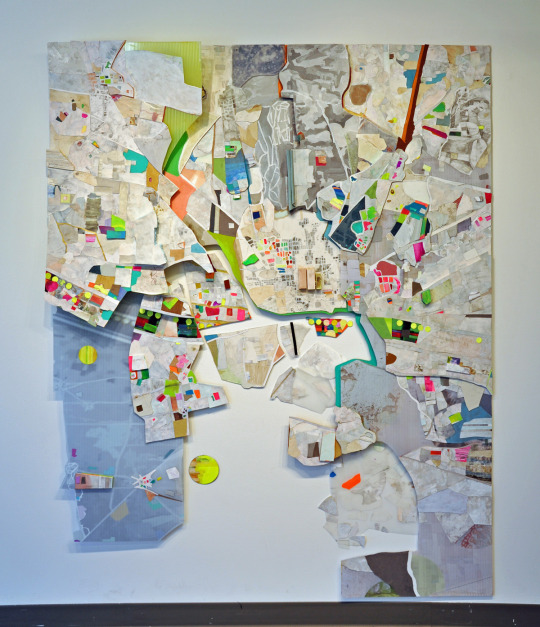
Jennifer Mannebach: YOU NEVER HELD IT AT THE RIGHT ANGLE2020 | 88 X 72 X 3”,wood, plastic, paper, mylar, acrylic paint, felt, leather, foam core, graphite
Considering the political climate, how do you think the temperature is for the arts right now, what/how do you hope it may change or make a difference?
Many artists are developing a better social justice radar even if specific issues don’t show up in their work. To me this all comes back to empathy, paired with visual literacy. Sure, there is some virtue signaling out there that may have more to do with following a trend, but my (perhaps naïve) hope is that the disruptions of the past year have resulted in an authentic reexamination of priorities and hierarchies.
People who think creatively are the ones who will be able to figure out actual steps forward. I see this already in some of the classrooms I’m in: teachers and artists working with students to identify what needs to change, and exploring what is possible. Yet, I do sometimes struggle to reconcile the poetic nature of what I do in the studio with the responsibilities I have as a citizen in the world.
I’ve been appreciating this passage from ‘Funny Weather: Art in an Emergency’ by Olivia Laing that explores the purpose of art- “Can art do anything, especially during periods of crisis? In 1967, George Steiner wrote a famous essay in which he observed that a concentration camp commander could read Goethe and Rilke in the evening and still carry out his duties at Auschwitz in the morning, regarding this as evidence that art had failed in it highest function, to humanize. But this makes art sounds like a magic bullet, which should reorganize our critical and moral faculties without effort, while simultaneously obliterating free will. Empathy is not something that happens to us when we read Dickens. It’s work. What art does is provide material with which to think: new registers, new spaces. After that, friend, it’s up to you.”
Artist Wanda Ewing, who curated and titled the original LFF exhibit, examined the perspective of femininity and race in her work, and spoke positively of feminism, saying “yes, it is still relevant” to have exhibits and forums for women in art; does feminism play a role in your work?
The events of the past few years have really underscored the devious power of misogyny, how it is hidden in plain sight, and how it intersects with racism. Statistics about the lack of adequate healthcare for Black women are shocking. Even the kind of scrutiny and the types of questions that are asked a female politician, reporter or public figure reveal embedded sexism. My desire to have agency through my work is not separate from my identity as a human being, or as a woman, and I am a feminist. When I think of the question: What is feminist art? – I find myself a little confused or unmoored and maybe that’s a good thing! There are so many interpretations and new ways to be inclusive, that it is hard to define. This tells me that the conversation is expanding.
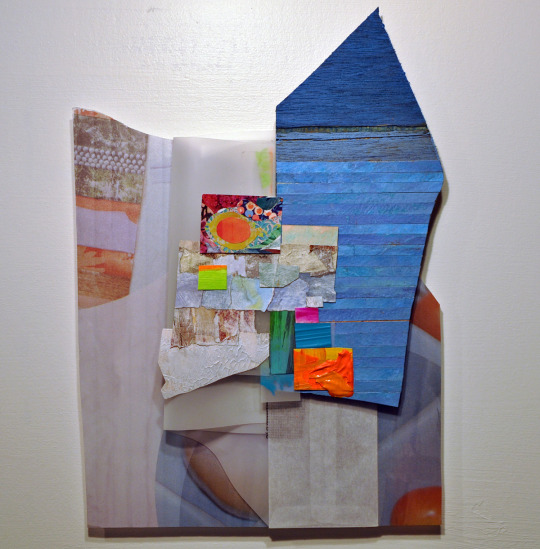
Jennifer Mannebach: PIQUE2020 | 13 x 9 x 1”, paper, paint, wood, mylar, digital print on polycarbonate, glassine envelope
Ewing’s advice to aspiring artists was “you’ve got to develop the skill of when to listen and when not to;” and “Leave. Gain perspective.” What is your favorite advice you have received or given?
There are several, but I’m going to share one that impressed me a great deal when I was an undergrad. I had just discovered a book about Eva Hesse that referenced her correspondence with Sol LeWitt. He basically told her to stop questioning and equivocating and just DO. (Everyone should have a friend like that!) I sometimes find it helpful to revisit this if I feel too much in my head and don’t want my fear or uncertainty to be paralyzing. I’ll attach one of the letters here-
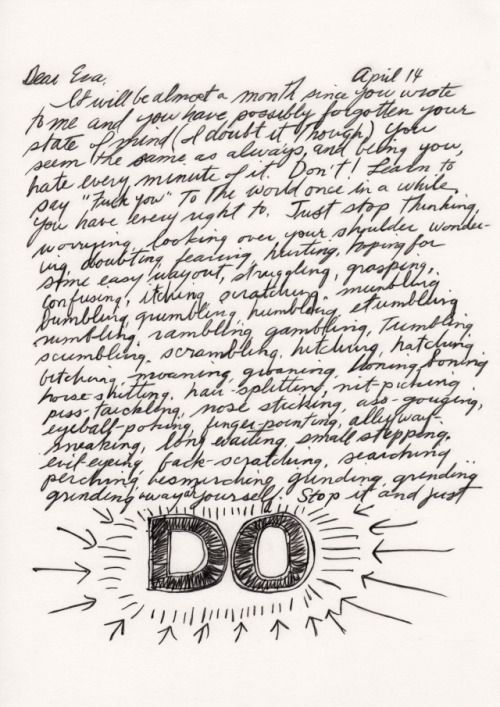
www.jmannebach.com
@mannebach_art
~
Les Femmes Folles is a volunteer organization founded in 2011 with the mission to support and promote women in all forms, styles and levels of art from around the world.
Submissions always open: https://femmesfollesnebraska.tumblr.com/callforart-writing
Check out the 10th anniversary LFF exhibit, Feminist Connect, here:
https://www.les-femmes-folles-feminist-connect.com/
0 notes
Text
Artist Feature: Alyssa Taylor Wendt
Alyssa Taylor Wendt is currently exhibiting her work in VESSEL with Brooke Gassiot at the ICOSA Gallery Collective in Austin Texas that through May 8th. She generously shares with LFF about her impetus for creating, her recent interactive projects and exhibitions, starting a nonprofit Museum of Cultural Artifacts, collaboration in her film work and collective, creating during this political climate and more.
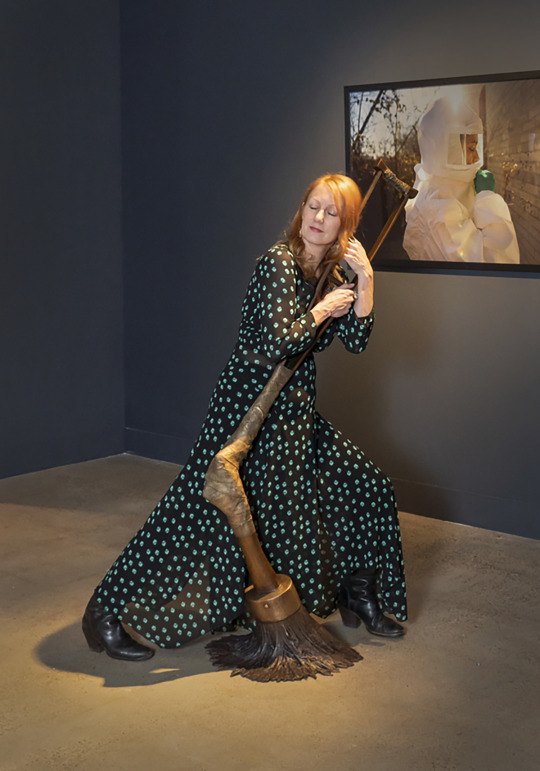
Portrait of the artist with her bronze, Cursorial Reciprocity, at the exhibition for H A I N T at the Visual Arts Center, UT Austin, 2019.Photo of the artist by Scott David Gordon. © Alyssa Taylor Wendt 2021, all rights reserved.
Where are you from and how’d you get into art? Greetings! My name is Alyssa Taylor Wendt and I am a multidisciplinary artist, filmmaker and curator who works in Austin, Texas and Detroit, Michigan. I am originally from New York City, but spent formative years in Phoenix and San Francisco. I have been making and showing work for about 20 years and hold an MFA from Bard College. You can see more of my work here: www.alyssataylorwendt.com.

LST VSSLZ installation at "Good Mourning Tis of Thee," DEMO Gallery 2017. © Alyssa Taylor Wendt 2021, all rights reserved.
What is your impetus for making work? I have been creative my entire life. It's almost as if I don't have a choice, it's a compulsion to create. The act of artmaking keeps me sane and balanced as a human being. I do consider it a privilege to be an artist, even though it's more difficult than people realize. You have to keep going even with the potential for rejection constantly coming at you from multiple directions, especially if you are doing this for a career. I have been lucky and work very hard. My art practice is a project-based practice which usually encompasses video installation, photography and sculpture in a variety of mediums. I make work to introduce a conversation about my ideas and invite the viewer to partake. Without this dialogue or an audience, I rarely have the desire to create things.
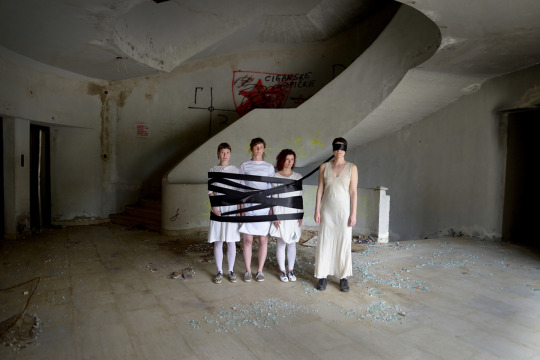
H A I N T: Uraniamädchen, photographic print, 2016. © Alyssa Taylor Wendt 2021, all rights reserved.
Tell me about your current shows and projects. I currently have a two-woman show called VESSEL with Brooke Gassiot at the ICOSA Gallery Collective in Austin Texas that is up through May 8th. We are both part of this 20 member artist-run collective and this show is about inhabited forms, spiritual residue and inherited memory. The seed inspiration for the subject matter was a film I made about collective genetic memory called TMI, which was filmed in Detroit, Flint and Texas. My films tend to be dark, cinematic and universal portals with which the viewer can insert their own reference points. This one is an endless interior space, knitted together from 22 abandoned commercial spaces, where I have a variety of eclectic performances occasionally appear in the peripheral vision. The visual and aural journey evokes collective memory, emotion and contemplation, also serving as a responsive piece to the isolation produced by our current pandemic. I have a series of ceramic canopic jars in this show as well, entitled "From Within." The animal figures have built-in brass peepholes which serve as Stanhope Viewers, allowing one to see a miniature image of the other vessels. The symbolic meaning becomes that we hold each other with us inside ourselves.
The biggest exciting prospect on the horizon, however, is my upcoming museum in Detroit. I am starting a nonprofit Museum of Cultural Artifacts and currently enrolled in a second masters program through Harvard in Museum Studies. I estimate that we will open in 2023. Keep an eye out!
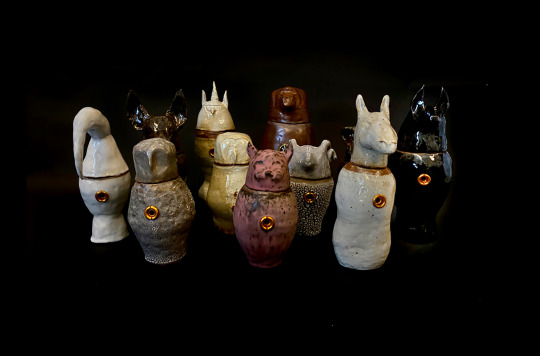
From Within, ceramic, brass, image, 2021. © Alyssa Taylor Wendt 2021, all rights reserved.
Does collaboration play a role in your work? Collaboration definitely plays a role in my process. That's what I love about filmmaking, I couldn't make the work without a team of incredible actors and crew! It feels like a giant collaboration even though I am the main producer, director, writer and production designer. Many of the shows I have done at our collective ICOSA have been collaborative, which is an incredible lesson in listening, compromise, teamwork and putting your ego aside hahaha. Lastly, I feel like my projects are a collaboration with the audience, since their experience, response and interpretation "complete" the cycle of why I make work to begin with.
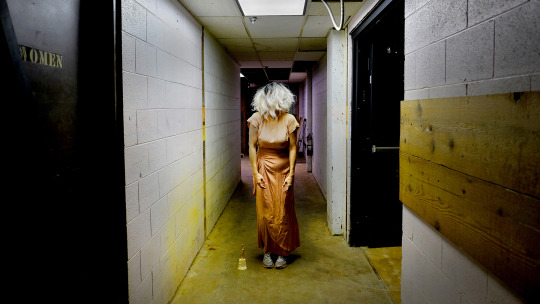
T M I: Llorando, photographic print, 2019. © Alyssa Taylor Wendt 2021, all rights reserved.
How do you feel about making work during this political climate? In consideration of the current climate and politics, I think this is an excellent time to be not only creative but PROACTIVE. No one is going to hand you the opportunities you want or need, so you just need to get up and make things happen. Gather friends, share ideas and take risks. With so many politically charged situations in our world, I think it's hard for artists who don't make "political" work to feel relevant, especially as curatorial work seems to favor this style at the moment. However, there still are the politics of life and being human, so essentially if people work from their inner truth, the intentions will come through and are just as valid as work which takes a stand. I think we really need more arts funding in this country, so it's not like a pack of wolves fighting for a dollar. More support would encourage collaboration, innovation and supportive communities instead of fostering the competition between artists which isolates people.
-
www.alyssataylorwendt.com
~
Les Femmes Folles is a volunteer organization founded in 2011 with the mission to support and promote women in all forms, styles and levels of art from around the world.
Submissions always open: https://femmesfollesnebraska.tumblr.com/callforart-writing
Check out the 10th anniversary LFF exhibit, Feminist Connect, here:
https://www.les-femmes-folles-feminist-connect.com/
0 notes
Text
Blog at 40, Mickalene Thomas at 40
It’s been a bit since my last blog at 40 but it’s always on my mind! Mickalene Thomas is an artist I’ve admired for a long time, probably since Wanda Ewing introduced her to me about a decade ago -- which happens to be 2011, Thomas’ 40th year.
I remember viewing this work at the Brooklyn Museum

Mickalene Thomas, American, born 1971: A Little Taste of Outside Love, Acrylic, enamel and rhinestones on wood panel, 2007
Per From Brooklyn Museum website:
Mickalene Thomas creates monumental pictures that explore and challenge the representation and objectification of women, and black women in particular. She draws inspiration from images of iconic African American women, emblems of the Black Power Movement, and her mother’s photographs from the 1970s. Here (above), she casts an African American woman as leading lady in an updated version of an established visual archetype—a sexualized female subject seemingly caught unaware as she reclines passively in her own beauty. In doing so, the artist turns the historic nude on its head and ousts the white European woman from the bed where she often lounges, attended by a black maidservant, in Western art.
A few years later (2011) Thomas created a series of works after 19th century French artist Gustave Courbet’s nude portraits of (white) women, such as this one:

Mickalene Thomas: Courbet 1 (Melody: Sitting), polaroid, in artist's frame, 2011
From Phillips Auctions on these works:
She produces portraits of African American women using vocabularies of the art historical canon and contemporary celebrity photography to render her subjects as powerful agents of their identities. Often depicting her sitters, whom the artist frequently refers to as “muses,” in the poses of the odalisques of Jean Auguste Dominique Ingres and Édouard Manet, Thomas subverts traditional forms of representation and presents a complex and empathetic vision of the myriad experiences of Black woman in contemporary America. Her sitters return the viewer’s gaze, supercharging their potent presences.
I absolutely love Thomas’ breadth of work--notably her work using rhinestones and collage work--I had never seen this series after Courbet, these works have a more serious or dark aura, which I deeply appreciate and can learn from.
I have created two Feminist Tribute drawings after Mickalene Thomas. It is said that Thomas came to making art inspired by a retrospective of the work of Carrie Mae Weems while she was studying law in Portland, Oregon, and has since devoted herself to exploring identity in visual terms.
As a white woman I have different experiences, seeing and reading about Thomas’ works enriches my understanding and perspectives. Too, though I see much similarities in our exploration of ourselves in visual terms and through other’s artwork.
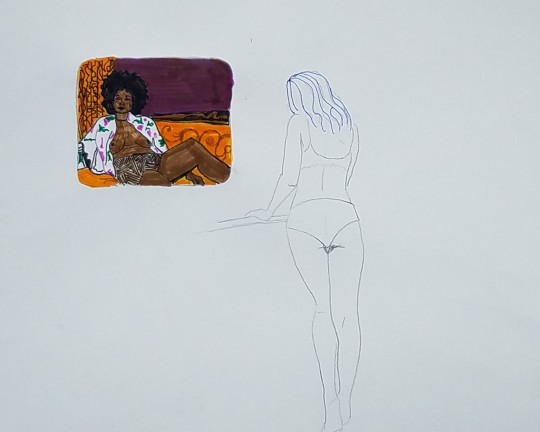
Sally Brown, Tribute to Mickalene Thomas II, 2020
I find the tension of my body and the mini-reproduction of Thomas’ bodies an authentic one, a strong one that pays homage while recognizing our different and shared planes.
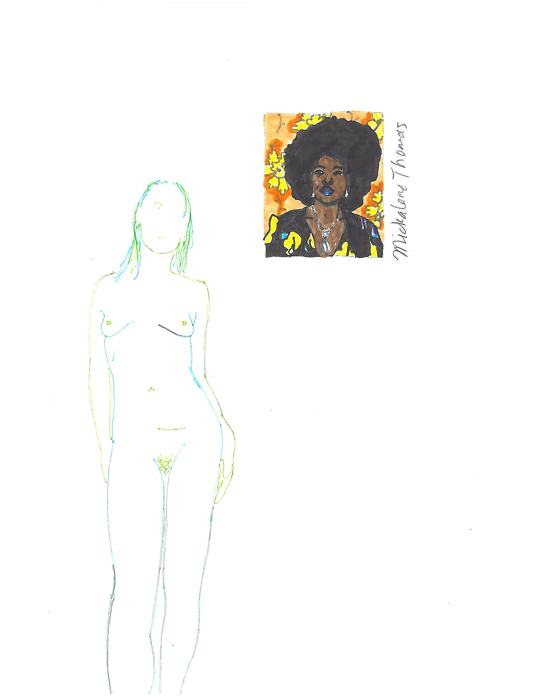
Sally Brown: Tribute to Mickalene Thomas II, 2019
Read up and find more of her work at https://www.mickalenethomas.com/.
-Sally Brown, April 3, 2021
IG @sallery_art
2 notes
·
View notes
Text
What does being a womxn mean to you and your work? Artist Tricia Townes responds
Artist Tricia Townes, who is featured in the LFF exhibit, Feminist Connect, responds to our prompt: "what does being a womxm mean to me/my artworks?"
Being a womxn means that the works I make are always framed around that sense of my ontological space. The work I present in this show is intensely personal because it is about my family, and as we know the personal is always political. Further, as an African-American womxn, my body interjects politics into any room I enter on multiple levels, and I am always mindful of that fact. Any art I create necessarily does the same.
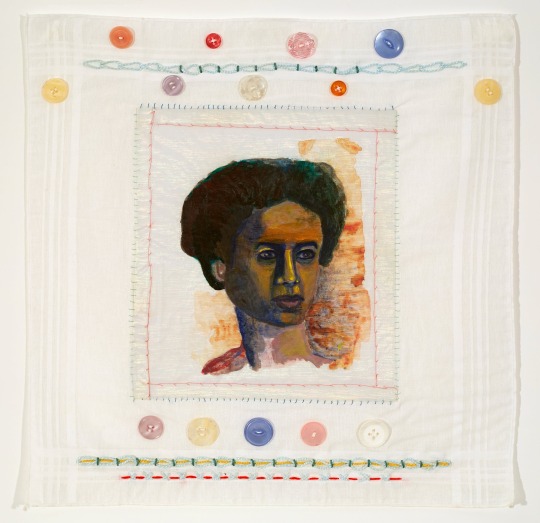
Tricia Townes: Mother. Find more of her work on Feminist Connect and https://tricialynntownes.com/home.html.
Join us tonight for our Artists-Curators Discussion. Register here. -
Les Femmes Folles is a volunteer organization founded in 2011 with the mission to support and promote women in all forms, styles and levels of art from around the world with the online journal, print annuals, exhibitions and events; originally inspired by artist Wanda Ewing and her curated exhibit by the name Les Femmes Folles (Wild Women). LFF was created and is curated by Sally Brown Deskins. LFF Books is a micro-feminist press that publishes 1-2 books per year by the creators of Les Femmes Folles including the award-winning Intimates & Fools (Laura Madeline Wiseman, 2014) , The Hunger of the Cheeky Sisters: Ten Tales (Laura Madeline Wiseman/Lauren Rinaldi, 2015 and Mes Predices (catalog of art/writing by Marie Peter Toltz, 2017). Other titles include Les Femmes Folles: The Women 2011, 2012, 2013, 2014, 2015 and 2016 available on blurb.com, including art, poetry and interview excerpts from women artists. A portion of the proceeds from LFF books and products benefit the University of Nebraska-Omaha’s Wanda Ewing Scholarship Fund.
Submissions always open: https://femmesfollesnebraska.tumblr.com/callforart-writing
Check out the 10th anniversary LFF exhibit, Feminist Connect, here:
https://www.les-femmes-folles-feminist-connect.com/
0 notes
Text
Artist Feature: Laurence de Valmy
Laurence de Valmy is one of the 40 international artists featured in LFF’s 10th anniversary exhibition, Feminist Connect. She shares with LFF about her impetus for creating art, exhibitions she is currently included in, her current project, her various collaborative projects and blog, creating art during this political climate, feminism and more... All images and text (c) Laurence de Valmy.
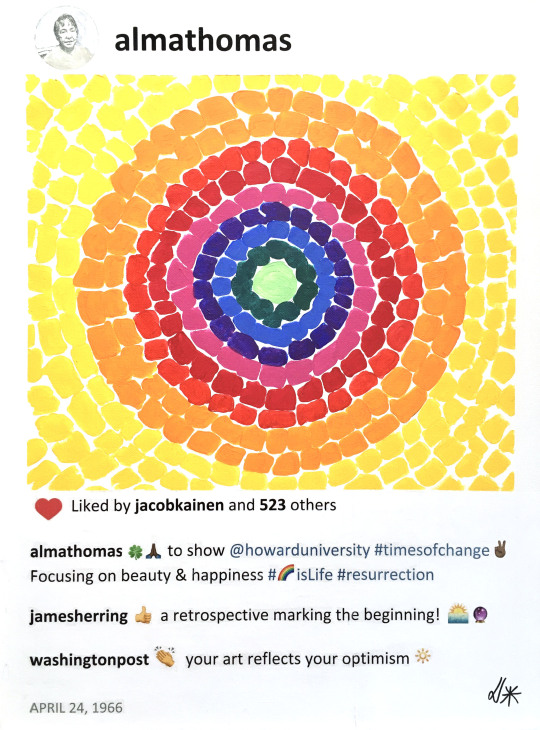
Alma Resurrection
Where are you from? How did you get into creative work and what is your impetus for creating?
I am Franco-American, born in Africa with family members on different continents. So I'm from here and there... I started to paint inspired by my mother who is an artist and art lover. My motivation in creating art is both sharing stories with my viewers and simply enjoying the intellectual and manual aspect of painting.
Tell me about your current/upcoming show/exhibit/book/project and why it’s important to you. What do you hope people get out of your work?
I am currently exhibited in several online exhibitions . Range of Art Gallery in Honfleur, France does both a physical and 3D room and I am part of online exhibitions such as REDis curated by Sergio Gomez, PRELUDE with Artcan.org. I am also celebrating Women History Month with Singulart, Kahn Gallery on top of the Feminist Connect.
My upcoming project is a series titled #HashtagsareART where I play with this communication tool and how it can both connect and replace images.
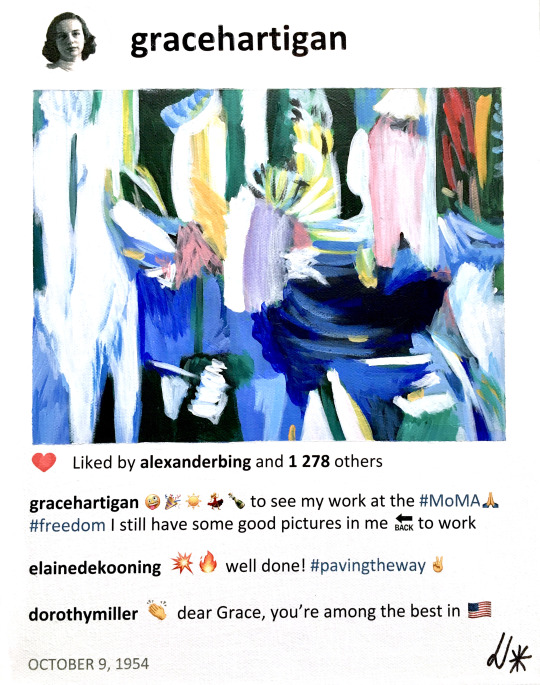
Grace at the MOMA
Does collaboration play a role in your work—whether with your community, artists or others? How so and how does this impact your work?
I am a big believer in the force of the team. I have been collaborating with Art Girl Rising and Kahn Gallery for the series featured in Feminist Connect for example. I am also an active member of Artcan, a non profit community of artists, of the Art Gorgeous House and I write for my blog The Curious Frenchy as well as publications such as French Quarter Magazine and Femmes d'Art. It impacts my work because I get to meet inspiring persons and we share opportunities.
Considering the political climate, how do you think the temperature is for the arts right now, what/how do you hope it may change or make a difference?
The current climate of the rise of nationalism concerns me and I am appalled by the lack of memory of people. At the same time, I think we are more free today to express our views than ever before. As artists, we can highlight how history matters and how we need to remember and improve things for current and future generations.
Artist Wanda Ewing, who curated and titled the original LFF exhibit, examined the perspective of femininity and race in her work, and spoke positively of feminism, saying “yes, it is still relevant” to have exhibits and forums for women in art; does feminism play a role in your work?
Feminism means equality. This is a value important to me and since I revisit history I decided to highlight women artists, but also women in the arts such as curators, collectors or critics who have been important and to help raise awareness about them.
I also feature many women artists on my blog The Curious Frenchy :-)
-
https://www.laurencedevalmy.com/
~
Les Femmes Folles is a volunteer organization founded in 2011 with the mission to support and promote women in all forms, styles and levels of art from around the world with the online journal, print annuals, exhibitions and events; originally inspired by artist Wanda Ewing and her curated exhibit by the name Les Femmes Folles (Wild Women). LFF was created and is curated by Sally Brown Deskins. LFF Books is a micro-feminist press that publishes 1-2 books per year by the creators of Les Femmes Folles including the award-winning Intimates & Fools (Laura Madeline Wiseman, 2014) , The Hunger of the Cheeky Sisters: Ten Tales (Laura Madeline Wiseman/Lauren Rinaldi, 2015 and Mes Predices (catalog of art/writing by Marie Peter Toltz, 2017). Other titles include Les Femmes Folles: The Women 2011, 2012, 2013, 2014, 2015 and 2016 available on blurb.com, including art, poetry and interview excerpts from women artists. A portion of the proceeds from LFF books and products benefit the University of Nebraska-Omaha’s Wanda Ewing Scholarship Fund.
Submissions always open: https://femmesfollesnebraska.tumblr.com/callforart-writing
Check out the 10th anniversary LFF exhibit, Feminist Connect, here:
https://www.les-femmes-folles-feminist-connect.com/
0 notes
Text
Featured writing by G.P. Gottlieb
G.P. Gottlieb responds to LFF’s prompt, “We Shall Overcome,” with a short story, “My Advice to Women.” All images and text (c) G.P. Gottlieb.
My Advice to Women G.P. Gottlieb
We lived on the first floor of a brick two-flat in a safe suburban neighborhood filled with young families, and I could walk with friends to the playground after I turned nine. One warm summer afternoon as we were leaving, I skipped over to the fountain for a quick drink, and a light-haired man grabbed me. It reminded me of a lion separating a little gazelle from the herd, like on the Mutual of Omaha television show we watched on Sundays, and I knew I had to push him away. I still remember that it was scary and confusing, and I ran from him to catch up with the friends who’d gotten ahead of me. I didn’t tell them what happened, and we spent the rest of the afternoon playing wall ball.
I forgot all about the odd experience until two days later, when a girl in the neighborhood was accosted. Maybe he held her tighter and she couldn’t push him or run away, but he managed to pull down her shorts. I remember feeling awful for the girl, but the playground incident felt like a hazy, bad dream by then. I told my mother that something similar had happened to me and asked if the man had light hair. I remember my mother gasped, made a phone call, and dragged me to our suburban police station to repeat the story to a police officer, who was the father of one of my sister’s friends. I don’t recall the words I used, but I still see the window next to the officer’s desk. And I remember being embarrassed to say where the man had touched me. The police officer kept asking questions even after I told the story. Then my mother told me to say thank you, and we left.
I’d just started reading The Bobbsey Twins and imagined how stunned everyone would be if I solved “The Case of the Bad Man.” I went to the playground as often as possible, hoping to see him, secretly follow him home, and tell my parents where he lived. I’m not sure why I thought I could follow a grown up, even on my bicycle, but I imagined becoming a neighborhood legend. I never saw the guy again, and anyway, I wasn’t allowed to cross major streets.
The children in the mysteries I read didn’t have street-crossing restrictions, always solved the crimes, and the bad guys were always caught. That’s the world I wanted to live in instead of one where I constantly worried about that feeling of being a little gazelle who could be easily separated from the herd. I was afraid to walk anywhere by myself and constantly checked under restroom stalls, around corners, behind trees. I still said thanks to men in the neighborhood who admired my long braids, but I wouldn’t answer if they asked me where I was from because I had dark hair and skin, and people thought I looked foreign.
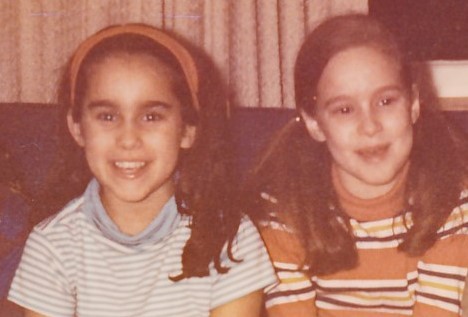
The author, age 9, and her sister.
I wrote snippets in my diaries that I thought of as the beginning of my crime writing career, but never finished a complete story. I was cautious as I grew up, rarely taking chances, usually aware of my surroundings, and always suspicious. Neighborhood kids would sometimes hang out at the park on summer evenings, but it wasn’t much fun for me because of the trees and shadows, too many places for a bad guy to hide. I kept lists of things back then, like favorite foods, favorite movies, books I loved, and the names of girls who’d been molested or assaulted.
I have vague memories of girls I knew who’d been assaulted during college, maybe vague because it happened all too often, and it often went unpunished. Just a few years ago a woman I know who’d been gang-raped in the basement of a fraternity recalled how little she’d been helped by the administration of her school, how she’d been forced to leave, and how it had scarred her entire life.
When I was already married and working in my field, I started writing a novel based on another true story. It was a about a dessert-loving young woman who attends a party and learns that special brownies are being served. Like what happened in real life, she eats a second brownie to try to deconstruct the ingredients. She doesn’t recognize that it’s a marijuana brownie, but now she’s high for the first time. A tall boy with long dark hair entices her into a bedroom and locks the door. Although in real life I managed to get out of the room intact, my character gets raped. Driving home, she loses her peripheral vision, causes an accident, and kills someone.
She falls apart and is forced to give up the baby girl she has nine months later. The guy who raped her gets caught raping someone else, goes to prison, joins a twelve-step program, and gets out early for good behavior. Now he’s trying to apologize to everyone he hurt, including my heroine, but she doesn’t want to be found. She changes her name and moves away.
It was all one long revenge fantasy about the blond-haired guy at the playground, the girls I knew who’d been assaulted, and the boy who tried to rape me after I ate the brownies, that night when I lost my peripheral vision. If any of that happened today, the incidents would be reported, the girls would be believed, and the perpetrators would pay the price for their behavior. I’m delighted to see women fighting back, going after men, especially when they’re rich and powerful, who abused or assaulted them years before. I’m grateful to the women who forced the system to change, and relieved that the justice system now works better on behalf of women.
But my advice to any woman who doesn’t feel like she’s been heard? Write a murder mystery. Transform the person who upset, hurt, or even just annoyed you into a vile character. Give him bad breath, yellow teeth, and a big gut – go wild with the description. Then have him murdered, preferably in a humiliating way. I promise you it’ll be extremely satisfying. Or, so I’ve been told.
-

G.P. Gottlieb has worked as a musician, a teacher, and an administrator, but she’s happiest when writing recipe-laced murder mysteries. Battered: A Whipped and Sipped Mystery (DX Varos 2019) and Smothered: A Whipped and Sipped Mystery (DX Varos 2021) take place in the spring and summer of 2019. G.P. Gottlieb is also host for New Books in Literature, a podcast channel on the New Books Network, has three grown children, and lives with her spouse in a Chicago high-rise that is strikingly similar to the building portrayed in the Whipped and Sipped Mystery series.
~
Les Femmes Folles is a volunteer organization founded in 2011 with the mission to support and promote women in all forms, styles and levels of art from around the world with the online journal, print annuals, exhibitions and events; originally inspired by artist Wanda Ewing and her curated exhibit by the name Les Femmes Folles (Wild Women). LFF was created and is curated by Sally Brown Deskins. LFF Books is a micro-feminist press that publishes 1-2 books per year by the creators of Les Femmes Folles including the award-winning Intimates & Fools (Laura Madeline Wiseman, 2014) , The Hunger of the Cheeky Sisters: Ten Tales (Laura Madeline Wiseman/Lauren Rinaldi, 2015 and Mes Predices (catalog of art/writing by Marie Peter Toltz, 2017). Other titles include Les Femmes Folles: The Women 2011, 2012, 2013, 2014, 2015 and 2016 available on blurb.com, including art, poetry and interview excerpts from women artists. A portion of the proceeds from LFF books and products benefit the University of Nebraska-Omaha’s Wanda Ewing Scholarship Fund.
Submissions always open: https://femmesfollesnebraska.tumblr.com/callforart-writing
Check out the 10th anniversary LFF exhibit, Feminist Connect, here:
https://www.les-femmes-folles-feminist-connect.com/
0 notes
Text
Whose Body, Self: Artist Nara Coló Rosetto
Nara Coló Rosetto responds to LFF’s prompt, Whose Body, Self?...and about her performance video, Paramentation protocol, 2020. All images and text (c) Nara Coló Rosetto. Photos by Clara Zamith.
Nara Coló Rosetto, 33 years old, based in São Paulo, my hometown. I work on different media such as documentation, mapping and cartography.
My research starts from a point of self-reference, motivated by the diagnosis and experience of an autoimmune disease characterized by chronic pain.
Through daily documentation and cataloguing, I seek to create collections on the vulnerability of the human condition, and pieces that portray everyday situations revealing both its fragility and invisibility. My works, in general, are made on delicate mediums that materially reinforce the contrast of the great intensity and the imperceptibility of the subject.
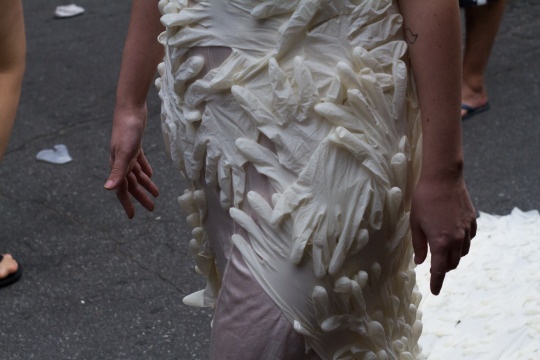
Photo by Clara Zamith.
Paramentation protocol - 2020
Performance
A white dress already within my family, worn by my cousin at her sweet sixteen celebration almost 30 years ago, covered with more than 200 latex gloves in the same tone as the fabric.
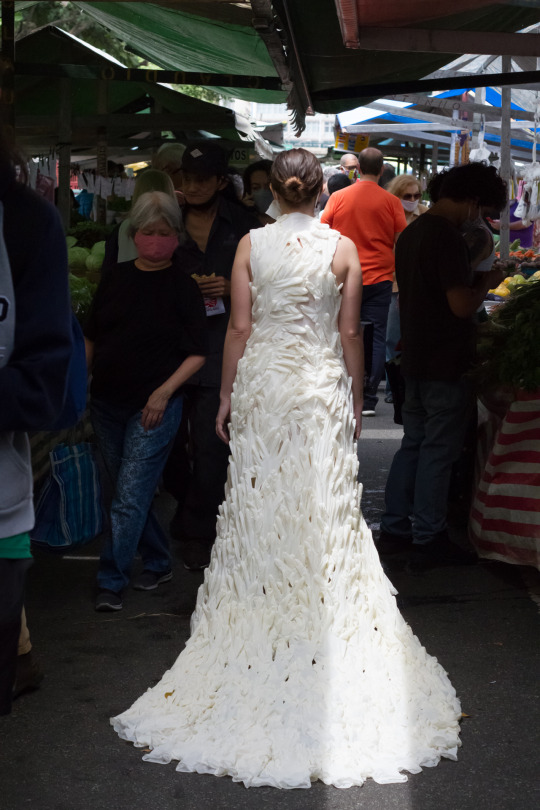
Photo by Clara Zamith. In a parallel with my own experience of numerous medical treatments due to a health condition, the gloves and mask can be both symbols of protection for the pandemic period in which we're living and health treatments. The gloves can also represent the hands that harass, assault and silence a woman's body - symbolising the growing number of women physically assaulted during social isolation.
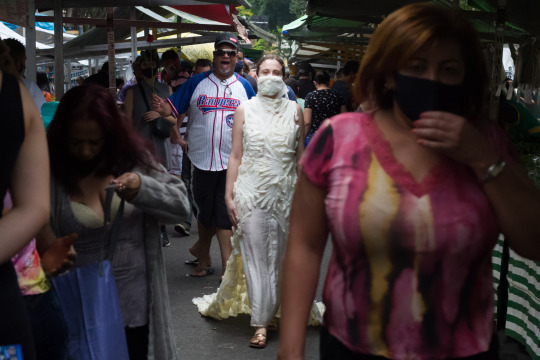
Photo by Clara Zamith. The tail, which formally conveys to us the image of a bride, is in fact a cascade of gloves hands that chase after/follow the walk at a 1.5m distance generate the physical social distancing requirement specified by the official Public Health bodies.
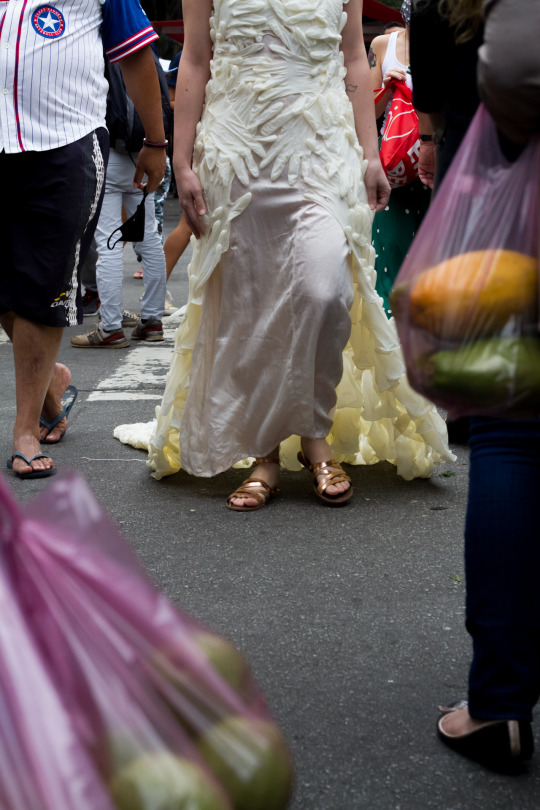
Photo by Clara Zamith. Thought of as “wearable”, the piece gains life and new meaning when activated during performance in urban spaces that are normally quite busy, e.g. street markets, pedestrian boardwalks, public squares and in interaction with the public. The strength of the ritual’s aesthetics, the familiar and immediately respected/invaded crossing, the interest of the audience in the clothing and sweeping of the remains along the way all appeal to the observers.
video - https://www.youtube.com/watch?v=iegJh7DQJmY
~
Les Femmes Folles is a volunteer organization founded in 2011 with the mission to support and promote women in all forms, styles and levels of art from around the world with the online journal, print annuals, exhibitions and events; originally inspired by artist Wanda Ewing and her curated exhibit by the name Les Femmes Folles (Wild Women). LFF was created and is curated by Sally Brown Deskins. LFF Books is a micro-feminist press that publishes 1-2 books per year by the creators of Les Femmes Folles including the award-winning Intimates & Fools (Laura Madeline Wiseman, 2014) , The Hunger of the Cheeky Sisters: Ten Tales (Laura Madeline Wiseman/Lauren Rinaldi, 2015 and Mes Predices (catalog of art/writing by Marie Peter Toltz, 2017). Other titles include Les Femmes Folles: The Women 2011, 2012, 2013, 2014, 2015 and 2016 available on blurb.com, including art, poetry and interview excerpts from women artists. A portion of the proceeds from LFF books and products benefit the University of Nebraska-Omaha’s Wanda Ewing Scholarship Fund.
Submissions always open: https://femmesfollesnebraska.tumblr.com/callforart-writing
Check out the 10th anniversary LFF exhibit, Feminist Connect, here:
https://www.les-femmes-folles-feminist-connect.com/
0 notes